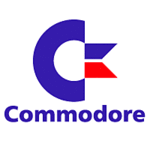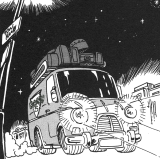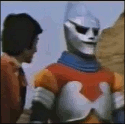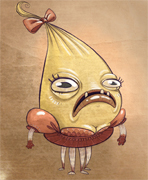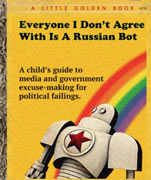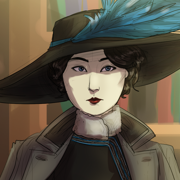|
Domus posted:That’s surprisingly complicated. Were tutorials that hand-hold not really a thing yet? The first commercial game I played, Wing Commander, was published about a decade after this, and did not have an in-game tutorial. You were expected to the read the manual in its entirety before playing. Neither did anything else I played that came out around that time. The first game I remember playing with an in-game tutorial was Thief, published 1998. I remember, in fact, being hugely impressed that it had this thing built in to the game that taught you how to play. Half-Life had one as well and came out at about the same time. Both of them were separate levels ("A Keeper's Training" and "Black Mesa Hazard Course") you accessed from the main menu rather than being built into the opening areas of the game, though. I can't offhand remember what the first game I played with a fully integrated tutorial was. It was established by Half-Life 2 but I'm pretty sure that wasn't the first. But ~15 years for separate interactive tutorials and ~20 for integrated ones sounds about right.
|
|
|
|

|
| # ? May 7, 2024 10:44 |
|
ToxicFrog posted:The first game I remember playing with an in-game tutorial was Thief, published 1998. I remember, in fact, being hugely impressed that it had this thing built in to the game that taught you how to play. Half-Life had one as well and came out at about the same time. Both of them were separate levels ("A Keeper's Training" and "Black Mesa Hazard Course") you accessed from the main menu rather than being built into the opening areas of the game, though. Though if you want to broaden the definition of "tutorial" to include RPGs where each NPC in the starting town explains one part of the battle system, that dates back a solid 10 years further to the days of the NES and DOS games. Though there's still the YMMV on the accuracy of the English translated text box.
|
|
|
|
Rocket Baby Dolls posted:I remember that the Infocom games had information that was only available in the manuals and nowhere to be found in the game, some of the games were almost impossible to complete without some key information contained within them. The old lord of the rings game had a CD version (which presented all the text from npcs in-game), and the non-cd version (which gave you lookup numbers in the manual, and had numerous decoy text boxes in case you tried to read ahead)
|
|
|
|
Rocket Baby Dolls posted:I remember that the Infocom games had information that was only available in the manuals and nowhere to be found in the game, some of the games were almost impossible to complete without some key information contained within them. Yeah, though how well-integrated it was depended a lot. On the good side, Suspended, which is almost impossible to play without the feelies because it is in fact a solitaire boardgame that the computer/text adventure interface is just refereeing for you. On the bad end, Zork Zero: The Revenge of Megaboz, which not only put almost all the clues in the manual, the in-game hint system for the question "what is even the basic goal of the game" was—literally—"Good luck, Blackbeard." ToxicFrog posted:The first commercial game I played, Wing Commander, was published about a decade after this, and did not have an in-game tutorial. You were expected to the read the manual in its entirety before playing. Neither did anything else I played that came out around that time. At some point this starts feeling like hair-splitting, but X-Wing (1993) had a very detailed training mode where you'd fly through an obstacle course, and then a "historical mission" mode that stepped you through the various mechanics of the game, all of which made reappearances in various forms in TIE Fighter (1994) and Descent: Freespace (1998) as well. You'd need to consult a reference card, but the manual was not strictly mandatory. The idea that an adventure should maybe include a fenced-off early section that gradually introduces the full mechanics bit by bit is also from that early-1990s era—Star Control 2's starbase rescue was a year before X-Wing. But yeah, none of that here. In Search of the Most Amazing Thing just dumps you face-first into a tar pit literally the size of Europe. EDIT: I seem to have overused "literally" in this post but no uses of it are intended to be figurative ManxomeBromide fucked around with this message at 23:57 on Nov 29, 2019 |
|
|
|
ManxomeBromide posted:On the bad end, Zork Zero: The Revenge of Megaboz, which not only put almost all the clues in the manual, the in-game hint system for the question "what is even the basic goal of the game" was—literally—"Good luck, Blackbeard." This is a fantastic "gently caress you" even by the standards of its time
|
|
|
|
The lines in the Mire have another purpose - the Mire Crabs won't cross them. If you happen to be near one when a crab comes after you, you can leverage them to get away. (I can't remember off the top of my head if this only works with double lines; I think it's both, though.)
|
|
|
|
idonotlikepeas posted:The lines in the Mire have another purpose - the Mire Crabs won't cross them. If you happen to be near one when a crab comes after you, you can leverage them to get away. (I can't remember off the top of my head if this only works with double lines; I think it's both, though.) Yep. Smoke even tells you this. I will be showing that off in the next update; it is hilariously abuseable. Driving on a zone line makes you nigh-invincible. (And it is indeed the minor sector lines too.) At the speeds I'm playing at, though, evading Mire Crabs once they've woken up is extremely difficult; you basically have to do the Baby Metroid Skip from Super Metroid across enough screens to reach a zoneline. Also, I haven't really set a spoiler policy here, but I do recall you saying you still remember the endgame. Please don't share until I actually post it. In other news, I've managed to crash the game again, and not in the two ways I already knew I could crash it. It looks like there will be a fully-featured Bonus Tech Update in here somewhere.
|
|
|
|
Part 4: Mire's Vault We finished the last update at the door of a Master Trader's hut. Before we go in, though, we'd better do our homework. And where better to do our homework than on the B-Liner's on-board B-Computer?  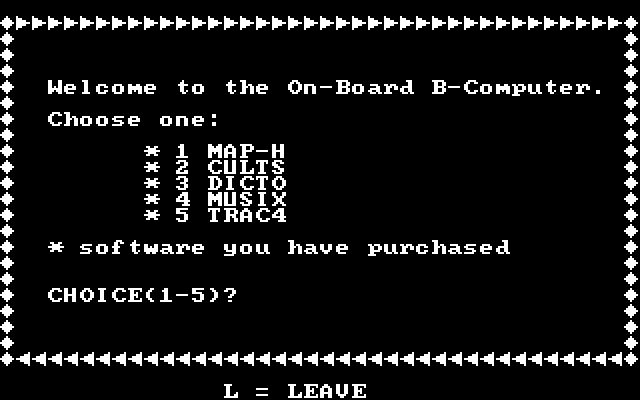 We start the game with TRAC4—the manual refers to it as "mystery software"—but we had to buy all the rest. All of these are necessary for getting the information needed to deal with the Mire Folk. The first program is Map-H. This provides maps of the Mire in each culture's region. We concluded, based on our consultation of the main maps, that we were in the territory of the Torbion culture. Let's make sure that's true. 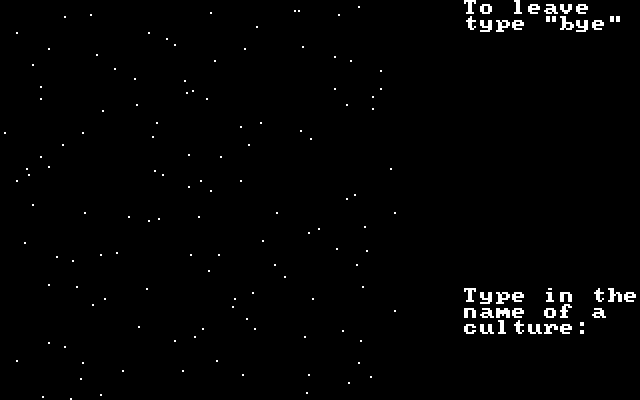 We do need to know the name of the culture we're asking about. 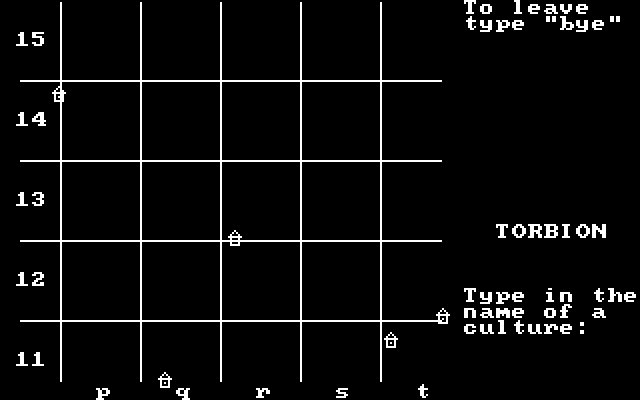 And there we are, right at the border of R12 and R13. This is the right place all right. We move on to check the CULTS program to see what information we'll need to know about them: 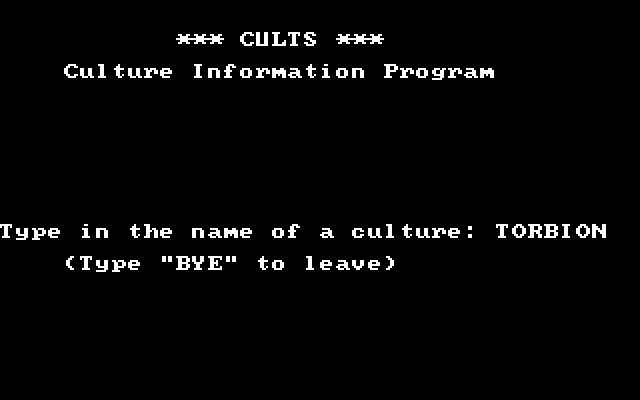 And, again, we enter the name of the culture directly. 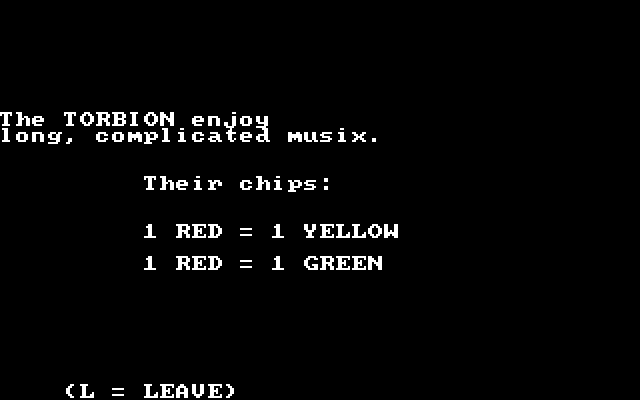 This gives us that culture's exchange rates, and also tells us what kind of Musix they like ("simple" or "long and complicated"). The Torbion like long Musix and will let us freely exchange our chips to any color we want. On to DICTO: 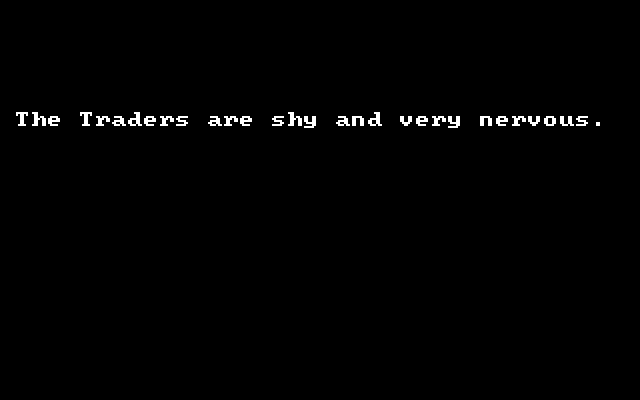 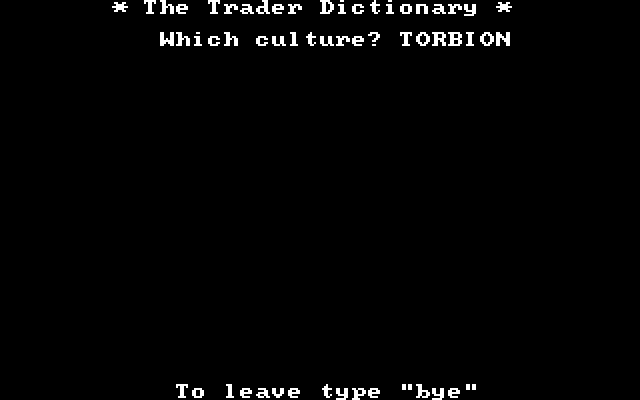 Yet again, a free response prompt. 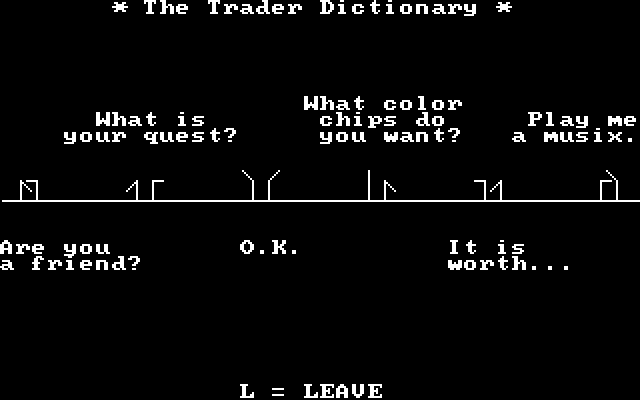 And here are the things that the traders can say. I write this down for future reference. CULTS told us that the Torbion like long, complicated Musix. What is a Musix, anyway? Well, it's the fourth entry on our list. 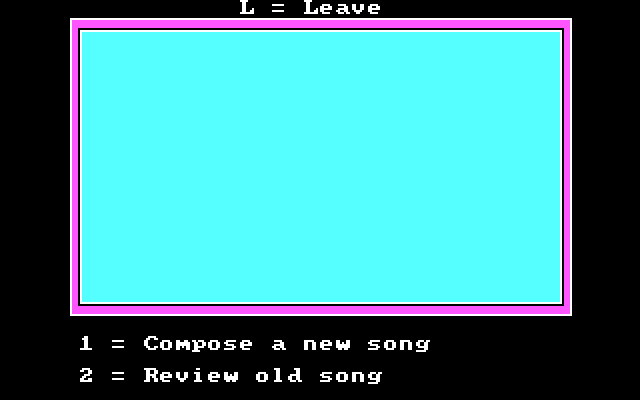 It opens with New/Load... 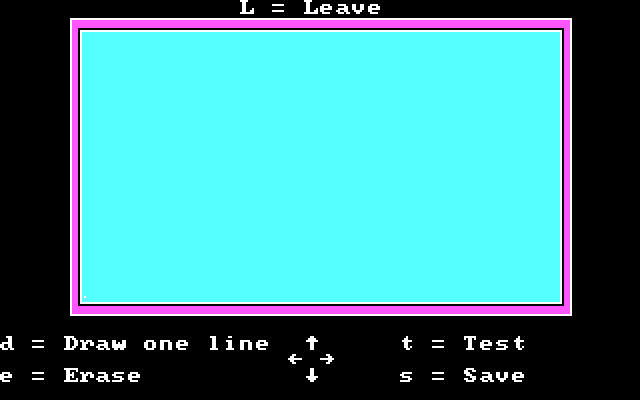 And once we pick New we get a little cursor we can move around in the space. Every time we hit "draw" it draws a line from the previous point to the place we are now and plays a tone. 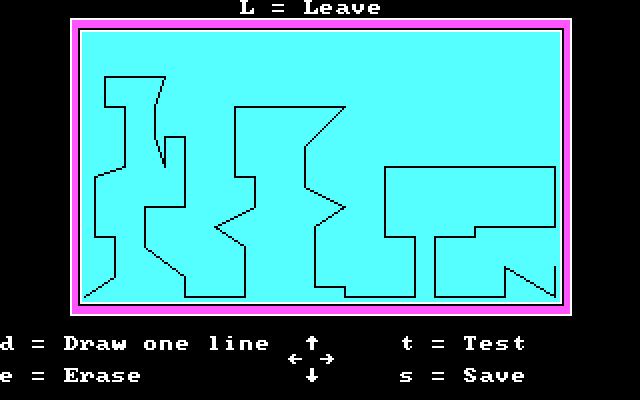 This ought to be long and complicated enough to keep the Torbion happy. The last program, Trac4, just draws and erases pixels at random points on the screen and plays random tones. It is pretty much The ChokesWare Seizure Inducer but with much less risk of seizing since there's usually just a couple dots bouncing around. Here is a video of Trac4 in action. OK, homework done. Let's go talk to the Torbion head trader. 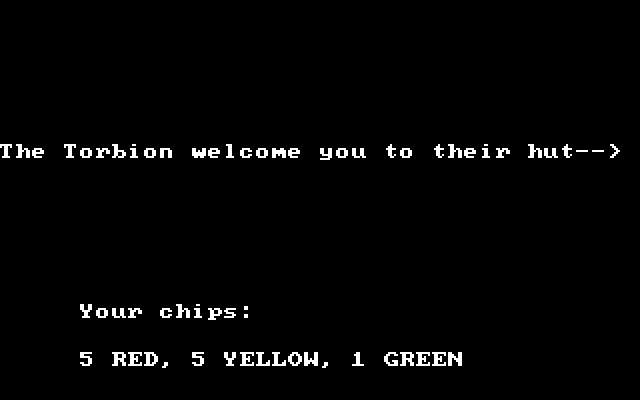 If for some reason we didn't have our map, or a list of the 25 mire culture names, we are informed immediately what we should have been looking up. 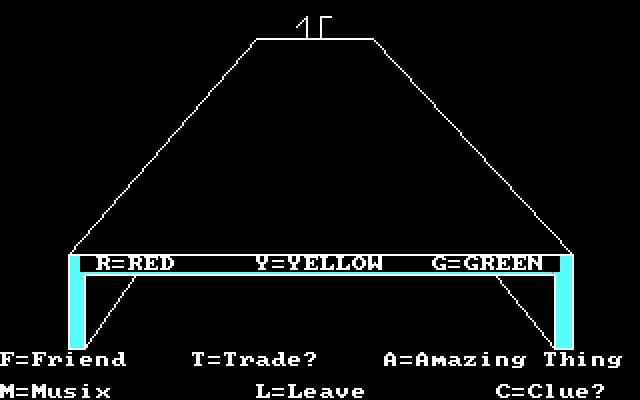  : Wait, you're not one of us. You don't even look like you're even from Porquatz. What are you doing here? : Wait, you're not one of us. You don't even look like you're even from Porquatz. What are you doing here?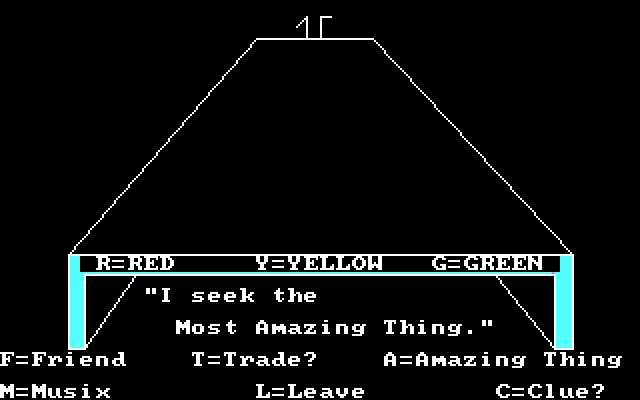 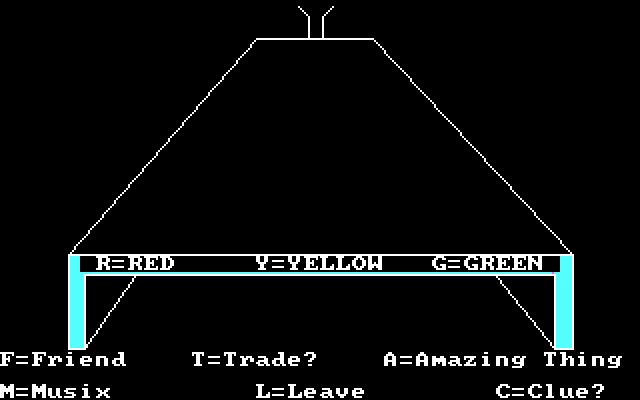  : OK, checks out. Now, what is a clueless, antennaless weirdo like you doing here? : OK, checks out. Now, what is a clueless, antennaless weirdo like you doing here? : Being clueless, mostly. I heard you sell clues. : Being clueless, mostly. I heard you sell clues.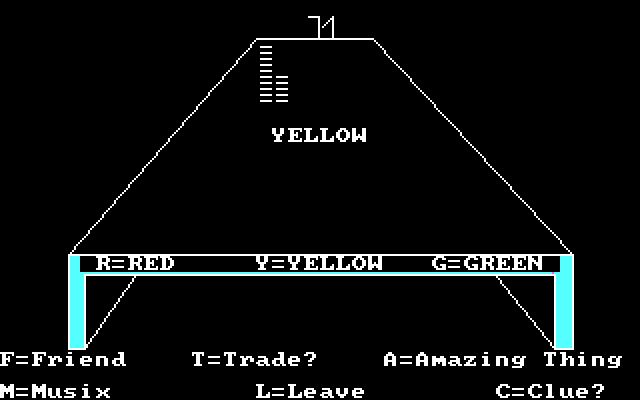  : Sure do. Best clues around. Only 15 yellow chips. : Sure do. Best clues around. Only 15 yellow chips. : Crud. That is, like, three times my budget. Um, what will you trade for chips? : Crud. That is, like, three times my budget. Um, what will you trade for chips? : Other chips, mainly. : Other chips, mainly.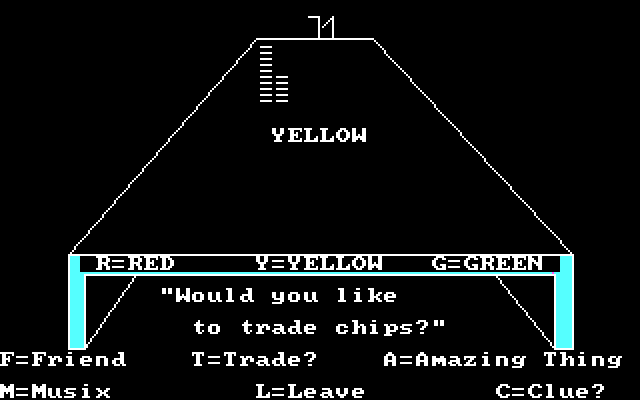 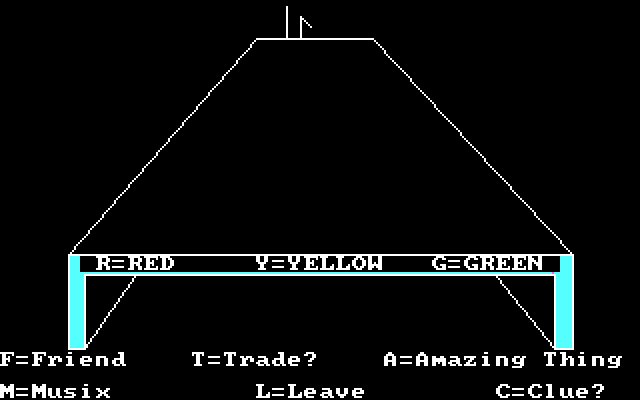  : Which chips were you wantin', again? : Which chips were you wantin', again? : Uh, yellow, so I can buy that clue? : Uh, yellow, so I can buy that clue? : Right, right, just leave them on the table, we'll sort it out. : Right, right, just leave them on the table, we'll sort it out.  : Well, here's everything I've got. : Well, here's everything I've got. : OK. : OK.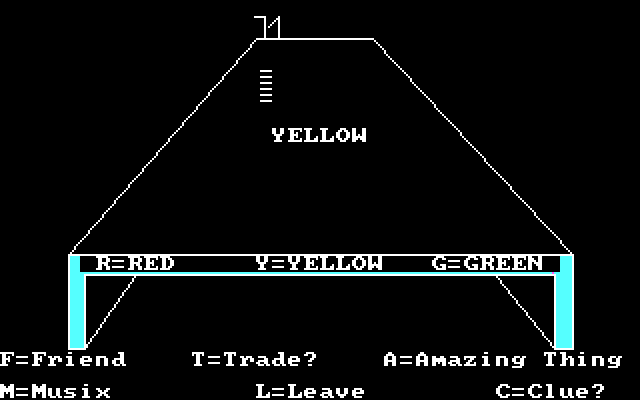  : Here's what it's worth. Enjoy your six new yellow chips. : Here's what it's worth. Enjoy your six new yellow chips.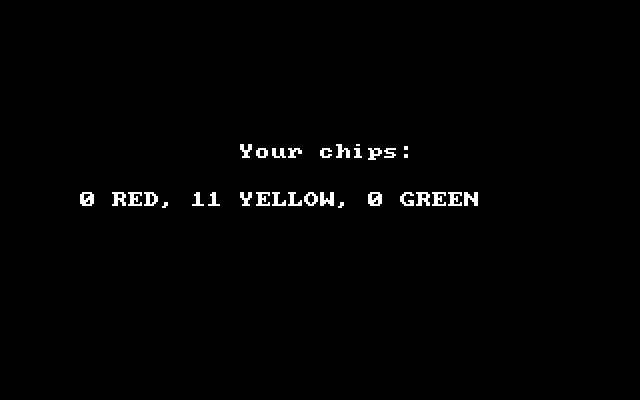  : That's still not enough to buy your clue. : That's still not enough to buy your clue. : Yeah, well, it's a tough life out in the Mire. Have you considered selling useless trash to the Metallicans up north? They seem to like it. : Yeah, well, it's a tough life out in the Mire. Have you considered selling useless trash to the Metallicans up north? They seem to like it. : Most of those rusty Metallicans have never been outside. : Most of those rusty Metallicans have never been outside. : Hmm. I'll just be going now. See you later. : Hmm. I'll just be going now. See you later. : Not if we get advance warning you won't. : Not if we get advance warning you won't.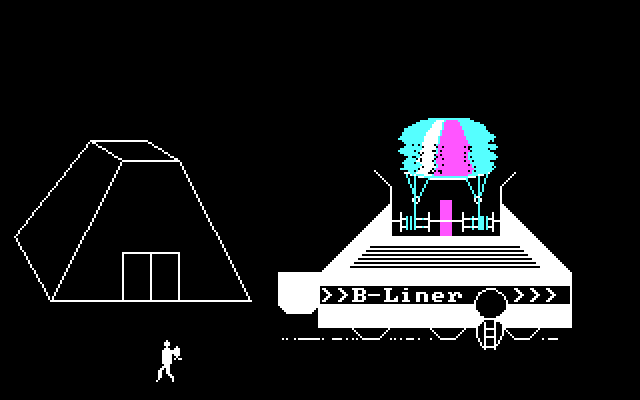 I haven't actually mentioned this before now, but it does turn out that the tarry surface of the Darksome Mire is safe to stand on. You can't walk on it, but your jetpack will let you out and you don't really sink or anything. Back in the B-Liner, we have some decisions to make. We could go back to Metallica, sell some stuff for green chips, and then swap them at par for yellow chips back with the Torbion traders. Or, we could look at the exchange rates at the neighboring cultures. 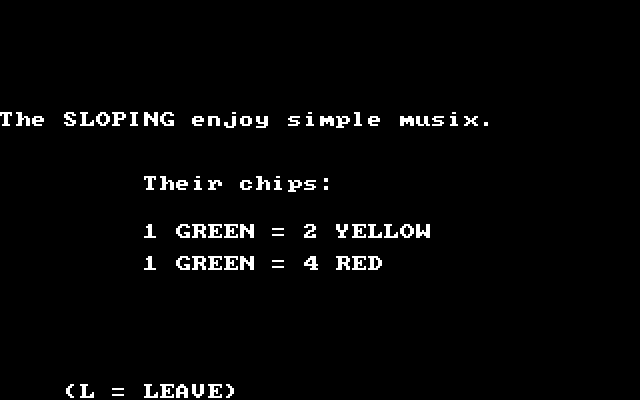 That looks extremely promising. 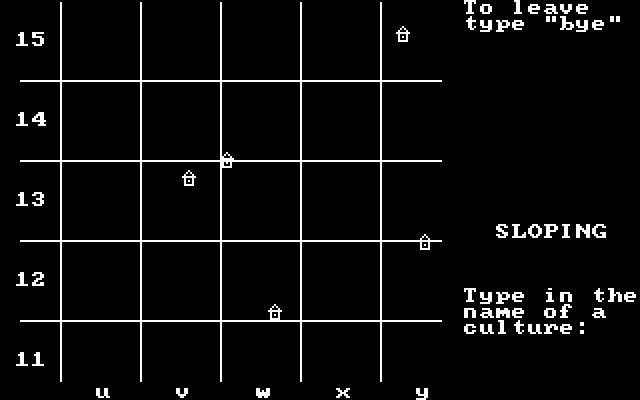 And they're right next door, too. Too bad doors on Darksome Mire are 400 miles apart. Also, while that exchange rate from green chips to yellow chips is favorable, we currently have zero green chips. We could go to Metallica for some green chips. But we're parked right outside a Torbion trade hut right now.  : You again? I don't have time for this. I'll be farming this out to my assistant. Answer his questions properly and everything will be fine. : You again? I don't have time for this. I'll be farming this out to my assistant. Answer his questions properly and everything will be fine. : What if I don't answer correctly? : What if I don't answer correctly? : Then you are cast into the Mire of Eternal Peril and we will refuse to deal with you again until you perform a sufficiently entertaining song and dance routine. : Then you are cast into the Mire of Eternal Peril and we will refuse to deal with you again until you perform a sufficiently entertaining song and dance routine. : Traders will not talk to you if you ever give a bad answer. : Traders will not talk to you if you ever give a bad answer. : If a Trader won't talk give him a Musix to soothe him. : If a Trader won't talk give him a Musix to soothe him. : Don't ever waste a Musix with a Trader. You may need it. : Don't ever waste a Musix with a Trader. You may need it. : Sounds good. : Sounds good.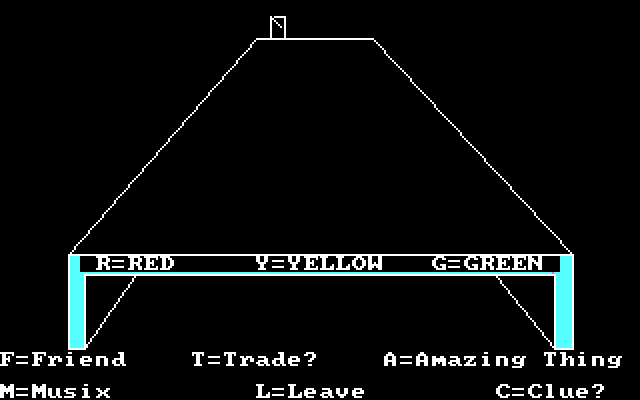  : What is your name? : What is your name? : What my name is is not important. What is important is... : What my name is is not important. What is important is...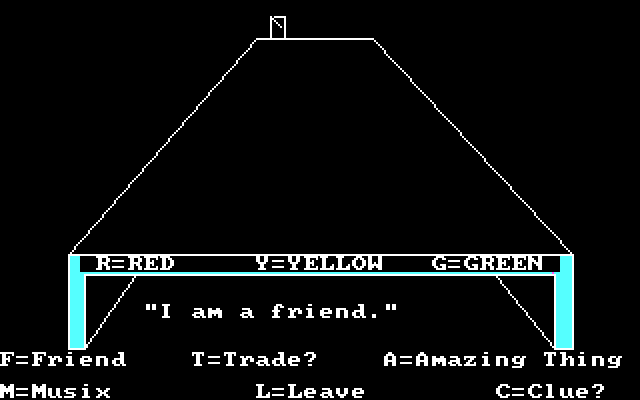  : OK. : OK. : Want to trade chips? : Want to trade chips? : What is your quest? : What is your quest?  : We covered this. I seek the Most Amazing Thing. : We covered this. I seek the Most Amazing Thing.  : What is... your favorite color? : What is... your favorite color? : ... green. Definitely green. And not yellow. Here, take all these yellow chips. : ... green. Definitely green. And not yellow. Here, take all these yellow chips.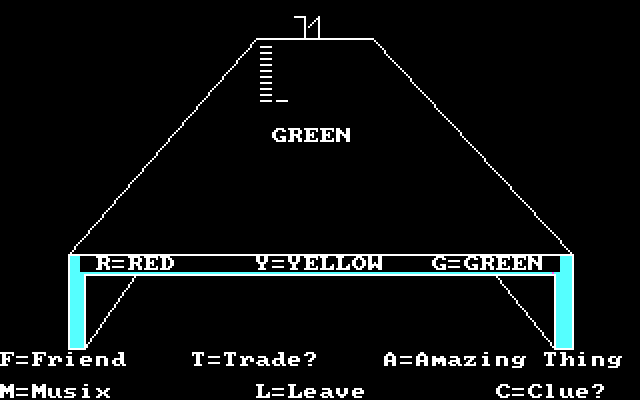  : :   : :  Traders have a slightly randomized but predictable protocol. When we first come in they challenge us with a question which we must answer correctly ("I am a friend" or "I seek the Most Amazing Thing"). Assuming we do, they say "OK" and we can ask for clues or to trade chips. If we ask to trade chips, they might ask us what color ships we want, or they might rechallenge us. We have to pay attention. If we ask for a clue, they compute a price based on their appraisal of our total net worth in chips. Unless we're carrying seriously implausible numbers of chips, they will usually end up asking for just about everything we have, or maybe a little more, as we've seen here. Once a price is set, though, it's fixed—across all cultures—until we buy the clue. So let's go meet that price. The nearest trader of the Sloping culture is in sector V13. We can get a good east wind at a relatively low altitude, so this trip won't cost much fuel. 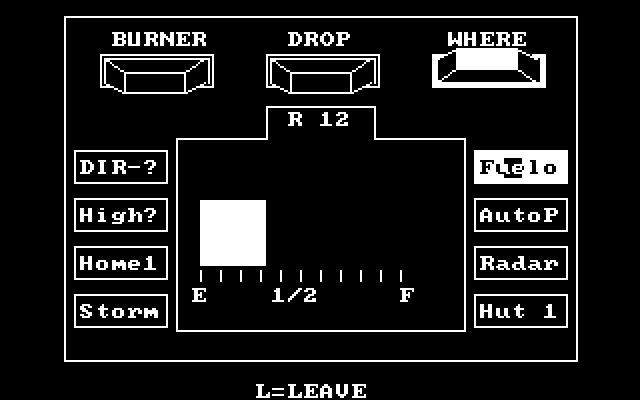 Which is good, because I didn't bother refueling before I took off. 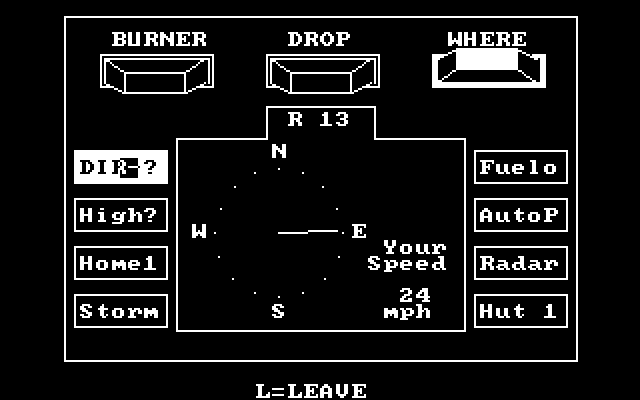 Off we go. 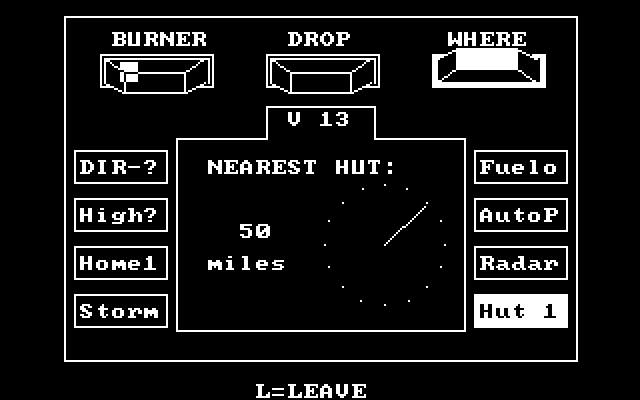 As we reach sector V13 we drop down a bit so we can head more directly towards the hut. 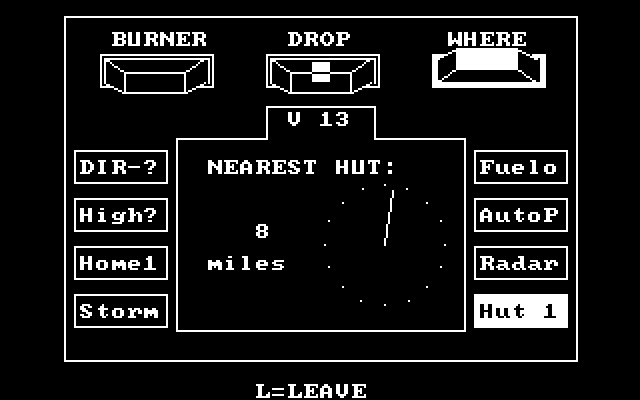 Much more directly. I bring us down before we smash through their roof. 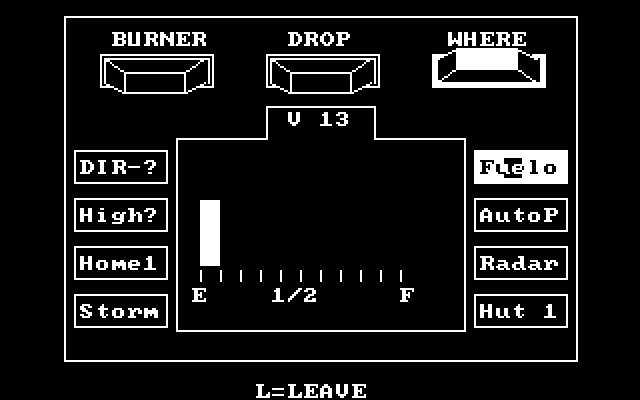 See? We totally didn't need to refuel for this. 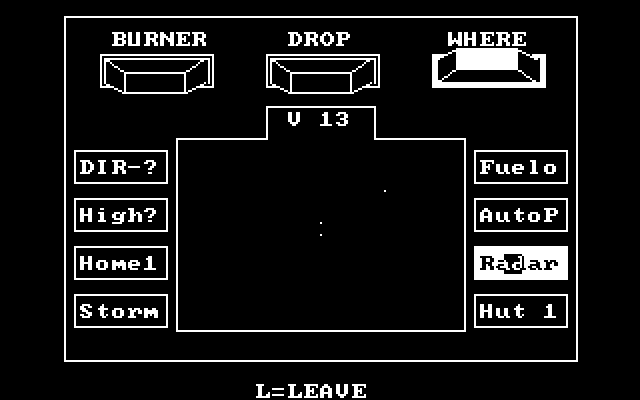 Radar is one of the two remaining B-Liner controls I haven't shown off. It gives occasional blips for huts in range. This chunk of V13 is the only place in the Mire I've found where you can even see two huts at once, and they're both the same culture and thus interchangeable. 90% of the time if you check your Radar it will just say NO HUTS FOUND because they're more than like 50 miles away. Radar is useless. Hut 1 has infinite range and is basically always what you want. 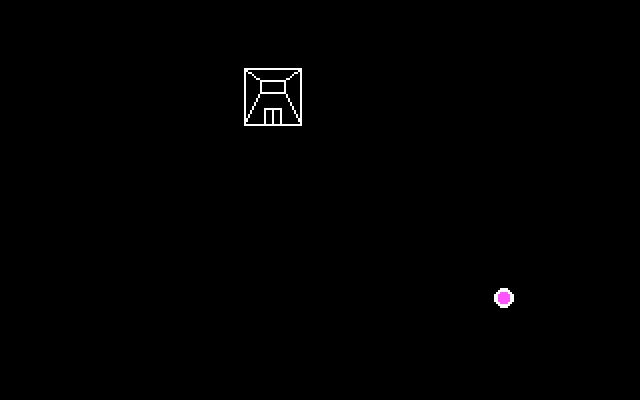 Speaking of huts, here we are, after five minutes of travel including refueling, and it's a much better view of one from the driving screen. Let's go pay them a visit. After learning their language, of course.  If you compare these gestures to the ones the Torbion use you'll find they're very similar. This is almost certainly an artifact of the way Trader talk is procedurally generated, but I like the idea that neighboring cultures are in the early stages of a dialect divergence here. 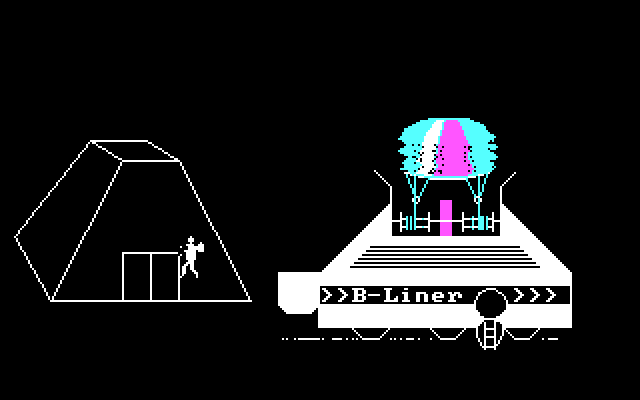 We can see their beady little eyes when the doors open; apparently upon seeing an 11-year-old kid with a jetpack they then all dive under the table once you show up. 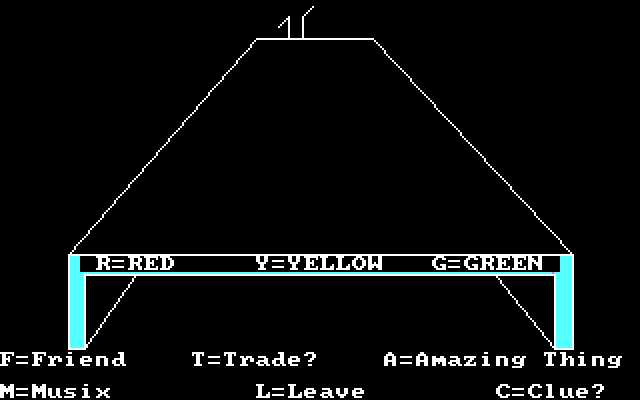  : Hey, we heard there's a farsider buying Amazing Thing clues for yellow chips. : Hey, we heard there's a farsider buying Amazing Thing clues for yellow chips. : That's me. I'm here to trade chips. I've got some green chips right here. : That's me. I'm here to trade chips. I've got some green chips right here. : Great. I'll dig out our store of yellow. : Great. I'll dig out our store of yellow. : Oh, there must be some mistake. I want red chips. : Oh, there must be some mistake. I want red chips. : Buying a clue in pennies, are you? Rude. Well, here you go. Don't let it sink you into the Mire. : Buying a clue in pennies, are you? Rude. Well, here you go. Don't let it sink you into the Mire. : No worries. Off I go! : No worries. Off I go!Now we've got to make the long trip back. But we don't have to go all the way back to the one we started at. Looking at the Torbion map in MAP-H, we can see that there is a much closer Torbion hut in the southeast corner of T12. That's only a couple map sectors over. Let's just drive it. 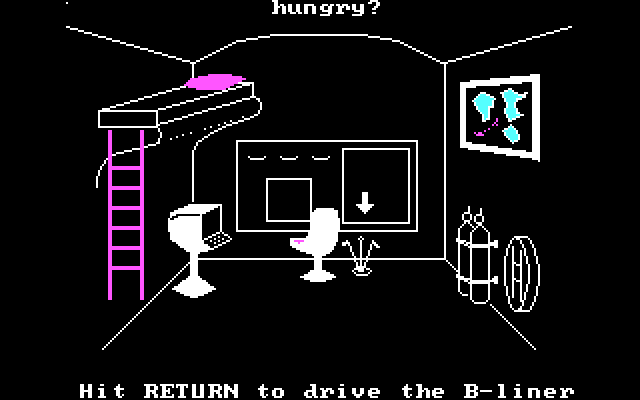 OK, and we'll get a snack along the way. Mire Crabs are going to be a problem, though.  : Those Mire Crabs can never leave their zone. You'll see. : Those Mire Crabs can never leave their zone. You'll see.It's true. As idonotlikepeas observed, Mire crabs cannot cross the parallel or meridian lines on the map. They're summoned by us going fast, but there's nothing stopping us from getting directly on a parallel and just gunning it.  And it's not just that they can't cross the line...  ...hitting the line vaporizes them. If they start out on the line, or if they manage to intercept us perfectly, we can still be attacked by Mire Crabs, but driving like this is much, much safer than most of our other adventuring has been. 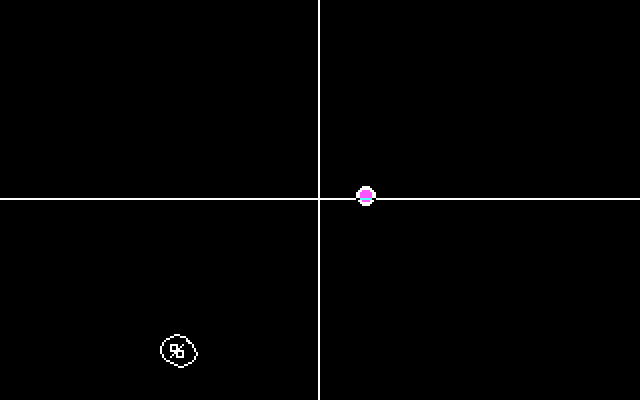 Here's a feature we haven't seen before. The manual doesn't have anything to say about these, but by process of elimination they must be what Smoke was talking about here:  : Look out for those Bunchmarks on the ground. They're soft. : Look out for those Bunchmarks on the ground. They're soft. : Bunchmarks are the biggest mystery on this planet. : Bunchmarks are the biggest mystery on this planet. : Tar around the Bunchmarks is very soft. Be careful. : Tar around the Bunchmarks is very soft. Be careful.These aren't impediments to our travel, but I have occasionally noticed that my sleep or hunger timers are much higher than they should be. I haven't found anything that would cause this effect, but who knows.  I don't know what went wrong with the bunchmark rendering here but it went horribly wrong  Anyway. Eleven minutes later, we have completed the drive. This has been your lesson in why flying is the correct way to traverse the Darksome Mire. Also...  I hit the wrong direction while flying over to the trading hut, and the game will happily scroll you off the screen from the B-Liner. Hope you remember which way you went because you're going to have to drift right back over to do anything... 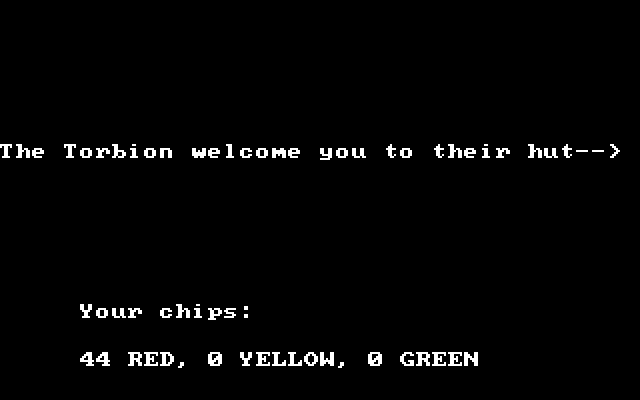  : You're back. : You're back. : Sure am. : Sure am. : Still 15 yellow chips for a clue. : Still 15 yellow chips for a clue. : Since when do you guys care about the color of chips, anyway? Here, take these red chips instead. : Since when do you guys care about the color of chips, anyway? Here, take these red chips instead. : Sorry, kiddo. Union rules. What I can do, though, is trade 15 of those red chips for yellow chips, and then accept the yellow chips for a clue. : Sorry, kiddo. Union rules. What I can do, though, is trade 15 of those red chips for yellow chips, and then accept the yellow chips for a clue. : OK. : OK. : There is one thing left you must do: : There is one thing left you must do: : : 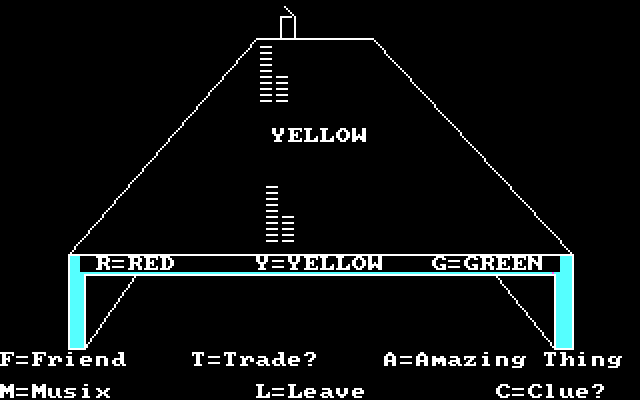  : You must dance. Dance for me the dance of your people! : You must dance. Dance for me the dance of your people!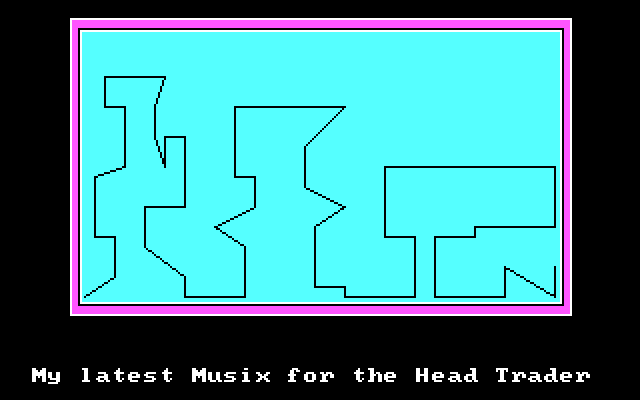 The Torbion like "long, complicated Musix." This turns out to mean "has 31 or more line segments in it". Simple enough to ensure.  : :  : :   : ... : ... : Worth it. OK, here's the story as we've heard it. You are not the first farsider to seek The Most Amazing Thing. Many years ago, there was another. He sought it with the assistance of one of the Mirefolk... Merton, of the Girfleez. If the stories we have heard are true, Merton and this farsider actually found The Most Amazing Thing, but for some reason they could not travel the Mire while carrying it. : Worth it. OK, here's the story as we've heard it. You are not the first farsider to seek The Most Amazing Thing. Many years ago, there was another. He sought it with the assistance of one of the Mirefolk... Merton, of the Girfleez. If the stories we have heard are true, Merton and this farsider actually found The Most Amazing Thing, but for some reason they could not travel the Mire while carrying it. : Too much weight for the A-Liner to lift, eh? : Too much weight for the A-Liner to lift, eh? : ... wait, have you heard this story? : ... wait, have you heard this story? : That farsider is my Uncle. Like him, I travel the mire in a hot-air balloon. : That farsider is my Uncle. Like him, I travel the mire in a hot-air balloon. : Those words are unfamiliar to us. : Those words are unfamiliar to us. : The farsider in the story is my father's brother. Like him, I cannot walk on the Mire. Like him, I fly over it with a big bag full of hot air. : The farsider in the story is my father's brother. Like him, I cannot walk on the Mire. Like him, I fly over it with a big bag full of hot air. : Oh, wonderful! : Oh, wonderful!  : Well, I guess that makes sense. : Well, I guess that makes sense. : I will let the network know that you, Bailey of the Floating Gasbag People, have joined some kin in the area. They should be less terrified of you in the future. : I will let the network know that you, Bailey of the Floating Gasbag People, have joined some kin in the area. They should be less terrified of you in the future. : That's... that's great. I suppose that's a better name than the Sarsparilla Cow People. : That's... that's great. I suppose that's a better name than the Sarsparilla Cow People. : What? : What? : Never mind. Another story for another time. : Never mind. Another story for another time.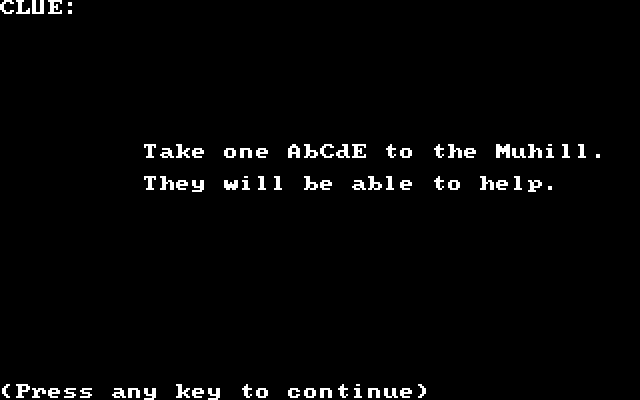  : All right. Now, Merton visited us for supplies on his way back to Girfleez territory. They're to our southeast, so the Most Amazing Thing must have been lost somewhere to the northwest. The locals there should know more. : All right. Now, Merton visited us for supplies on his way back to Girfleez territory. They're to our southeast, so the Most Amazing Thing must have been lost somewhere to the northwest. The locals there should know more. : I guess that's a start. : I guess that's a start. : Your best bet will be the Muhill. The northwest is a bit less advanced than we are here in Torbion territory—Metallica's our only spaceport and they're a lot further from it—so they're also a little more dubious about strangers. : Your best bet will be the Muhill. The northwest is a bit less advanced than we are here in Torbion territory—Metallica's our only spaceport and they're a lot further from it—so they're also a little more dubious about strangers. : I'm pretty used to that by now. : I'm pretty used to that by now. : Right, but here's your in: we happen to know that they've just finished upgrading their power generators. They'll be looking to import higher-tech items in the very near future, and the Metallicans stock a lot of computerized educational software. Pick up some of the self-contained educational computers they sell and bring them as an offering to the head trader. That should get you in good enough with them to learn what they know. : Right, but here's your in: we happen to know that they've just finished upgrading their power generators. They'll be looking to import higher-tech items in the very near future, and the Metallicans stock a lot of computerized educational software. Pick up some of the self-contained educational computers they sell and bring them as an offering to the head trader. That should get you in good enough with them to learn what they know. : Perfect. Thank you so much. : Perfect. Thank you so much. : Anything else you need? : Anything else you need? : Yeah. It sounds like I'll be trading with the Metallicans soon. The only thing they want from me is green chips. Can you hook me up? : Yeah. It sounds like I'll be trading with the Metallicans soon. The only thing they want from me is green chips. Can you hook me up?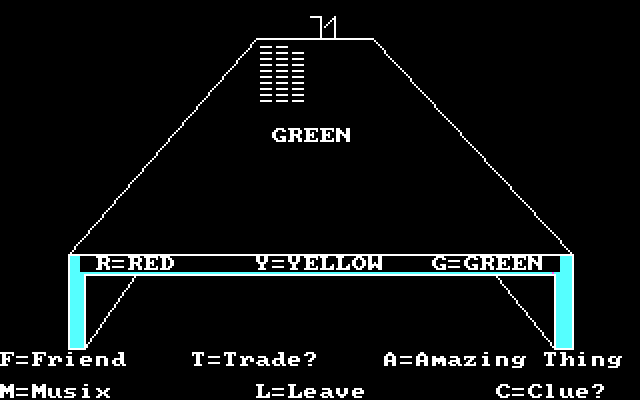  : You know it, Gasbagger. : You know it, Gasbagger. : I sincerely hope that sounds more dignified in your native language. : I sincerely hope that sounds more dignified in your native language. : Not really. I've got some books on ancient languages in the back, though. I'll let you know if we find anything good. : Not really. I've got some books on ancient languages in the back, though. I'll let you know if we find anything good. I wasn't expecting this. At any given time, only one culture actually has a real hint. Every other culture would have given us the hint "Go to TORBION. They know more than we do." But here, the closest hut to Metallica actually had the real hint. That is in no way guaranteed, but it gets us off the ground faster here. I wasn't expecting this. At any given time, only one culture actually has a real hint. Every other culture would have given us the hint "Go to TORBION. They know more than we do." But here, the closest hut to Metallica actually had the real hint. That is in no way guaranteed, but it gets us off the ground faster here.And speaking of getting off the ground, I guess we'd better head back to Metallica to buy that AbCdE.  : Aaaaaactually, we've got one last request for you, as you go. : Aaaaaactually, we've got one last request for you, as you go. : Yes? : Yes? : Can we watch you take off? : Can we watch you take off? : Sure! : Sure!Video of the entire trading session 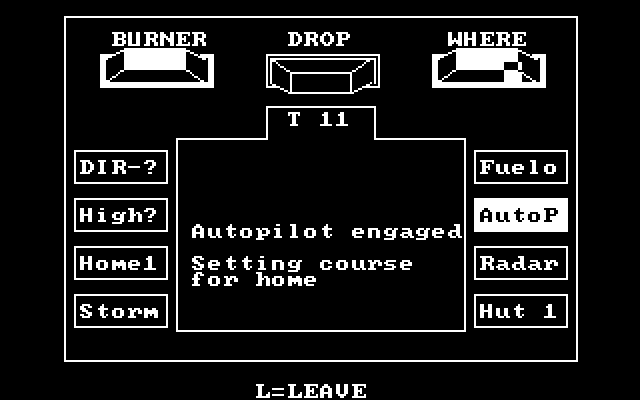 There's one last control we haven't tried yet; the AutoP function. This flies us back to the exact screen Metallica is on. It won't land us on Metallica—we do have to drive over to the entryway—but it'll get us close enough that the trip is trivial.  : Coooooooooooool. : Coooooooooooool.We can't do anything else while the Autopilot is on, though; changing any controls, or even leaving the control panel, will disable the autopilot and leave us drifting at wherever we were located. The BURNER and DROP switches alter themselves as needed. It's kind of cute. 90 seconds later... 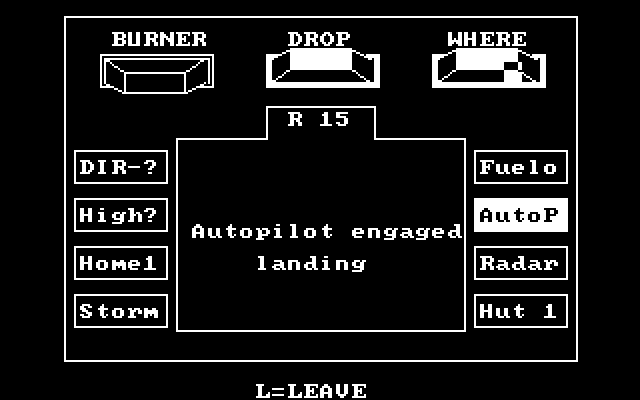 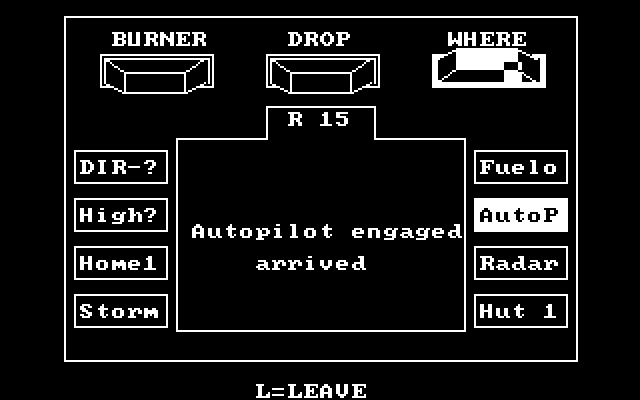 Let's go buy some overpriced gadgets. 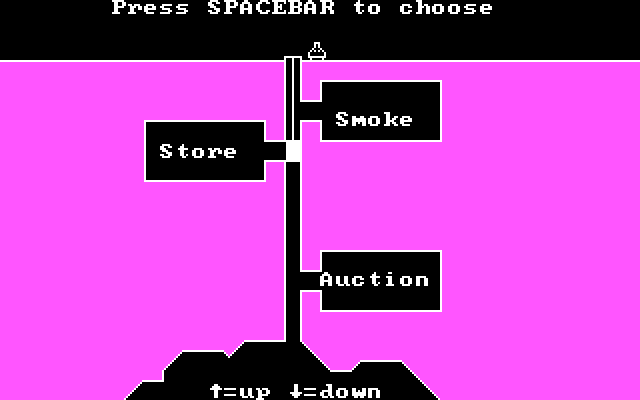  : Hey. : Hey. : Much obliged. : Much obliged. : Howdy. I'll allow it. : Howdy. I'll allow it.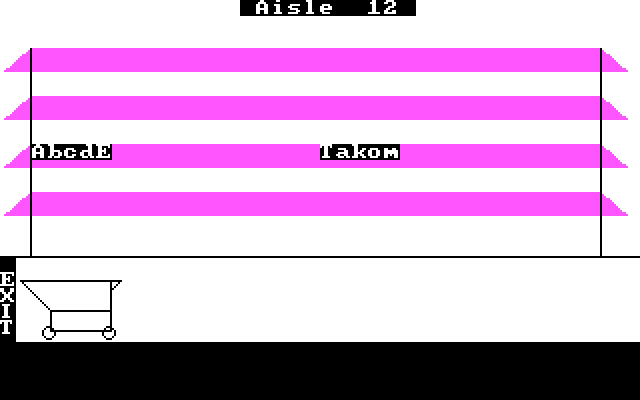 The manual does a rather clever trick here. The Catalogue is divided into three sections: quote:FLIGHT CONTROL PANEL METERS: These terrific meters will help you fly the B-Liner. It's true. The Metallican Household Items are not necessary for flying the B-Liner. That doesn't mean that they might not be necessary for solving the game. Which culture needs the gadget, and which gadget you need, is randomized on each playthrough. For us, though, we need the ABCDE. ABCDE is an "educational game for robot children." I assume that it would be effective for young Mire Folk as well. 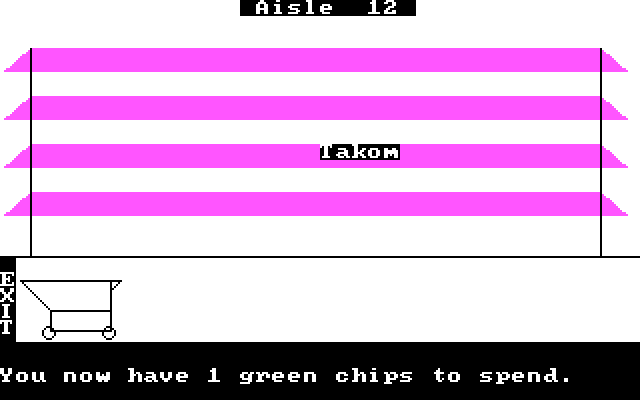 Hm. I think I will auction off a few more of Uncle Smoke's doodads before heading off to the Muhill, though. I'll want trade goods besides just the educational toy. ManxomeBromide fucked around with this message at 10:29 on Jan 1, 2020 |
|
|
|
Oh my gosh, this game. I remember going over to somebody's house and being very very bad at this game. I don't think we had the manual, which is part of the problem. I always wondered what the Most Amazing Thing was. As I recall, we spent way more time playing Lode Runner because we could understand it without reading a lot of backstory.
|
|
|
|
This game is roughly 10x as complex as absolutely anything else available for computers at the time, how is it even real? I had a flashback from your "oops flew the wrong way with the jetpack" screen; either I or one of the random kids who was often at the library at the same time as I had the idea that there must be secrets if you flew far enough either direction on that screen. Pretty sure there are no secrets.
|
|
|
|
The first time I went out in this game as a lad, I didn't have MUSIX. You can probably imagine exactly how well that went.ManxomeBromide posted:Also, I haven't really set a spoiler policy here, but I do recall you saying you still remember the endgame. Please don't share until I actually post it. Oh, jeez, I would never even consider spoiling that, don't worry.
|
|
|
|
Jet Jaguar posted:As I recall, we spent way more time playing Lode Runner because we could understand it without reading a lot of backstory. And even there, the mechanics in Lode Runner are not exactly super-obvious, and that's even before you get into it being one of the first games with  a built in level designer so you can torture your friends a built in level designer so you can torture your friends Dr. Quarex posted:This game is roughly 10x as complex as absolutely anything else available for computers at the time, how is it even real? ... says the poster with the Wasteland avatar.  We do remember how limited the scope had to be on things back then, but I think we often forget just how much people could manage to get done anyway. "How does this game even exist" does seem to be what leads me to LP things, though:
idonotlikepeas posted:The first time I went out in this game as a lad, I didn't have MUSIX. You can probably imagine exactly how well that went. As far as I can tell, trading MUSIX for clues and the high-tech gift from the end of the last update are the only two absolute, direct gear checks in the entire game. Everything else could in principle be bypassed with out-of-game knowledge or superhuman timing.
|
|
|
|
Much belated: Hey! I was unfamiliar with this, and it explains the graphics posted in the Ultima 1 thread when the Goon Bandwagon decided that it should also be an Alice in Wonderland crossover. Good times.
|
|
|
|
This is such a charming game! Thanks so much for LPing it, I had never heard of it before!
|
|
|
|
Uh-oh! They wanted an AbCdE but you bought an AbcdE instead. And for such an ancient game, it's amazingly cute that the shy traders are hiding under the table and poking their antennae out.
|
|
|
|
ManxomeBromide posted:Much belated: Hey! I was unfamiliar with this, and it explains the graphics posted in the Ultima 1 thread when the Goon Bandwagon decided that it should also be an Alice in Wonderland crossover. Alice In Wonderland looks a TON like Below The Root, another game from this era based on a story. I wonder what other super old games like this one I’ve completely missed.
|
|
|
|
FairGame posted:Alice In Wonderland looks a TON like Below The Root, another game from this era based on a story. Both of those were made by Spinnaker; specifically, they created a label called "Windham Classics" to put out games like this. They also released Swiss Family Robinson, Wizard of Oz, and Treasure Island, although those were done in a text adventure style with single graphics to illustrate particular scenes, if I recall properly.
|
|
|
|
Part 5: The Nonfunctional Era Starting up my next session, I was greeted with this screen immediately after loading: 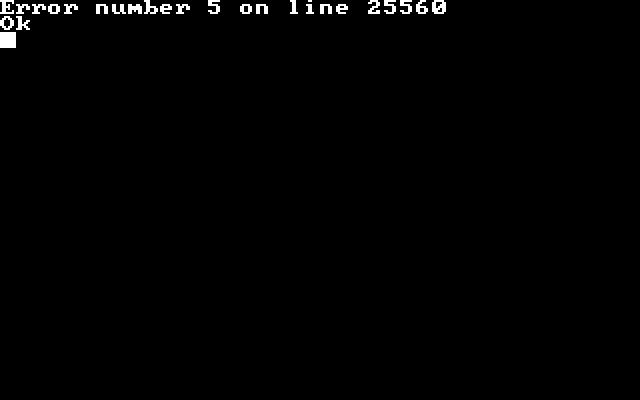 I'd been planning on comparing the DOS version of this game to the other three versions at some point this LP, so this seems like as good a time as any to do it. Despite being extremely cryptic, there are three important facts we learn from that message up top, or by looking more closely at what it implies and refers to:
How do you ship a game written in BASIC in 1983? On most systems, this is pretty easy. Two of the other platforms that the game was written for—the Apple II and the Commodore 64—had a version of BASIC burned right into their ROMs. On the C64, this was all you needed, and you'd just load the first file in and run it. On the Apple II, you also had to make sure that the disk was formatted and had enough DOS on it that you could load and run your files. The Atari home computers, however, did not ship with BASIC. You needed to have purchased the BASIC cartridge and have it plugged in. As long as that was in place, you could set up a disk with enough DOS on it to boot and then a startup program to kick you into BASIC and run the program. The PC was a weirder case, though. You had a DOS disk that you needed to boot off of, and you had an "advanced BASIC" named BASICA.COM that was on the DOS disk as well. In Search of the Most Amazing Thing relied on features of Advanced BASIC, but it didn't ship with it. Before you could run the game, you had to "install" it, onto itself, which appears to copy over BASICA and also set up the disk to properly autoboot into it. Why is running in DOS a terrible idea? All of that is well and good, but it turns out that in 1983, three-quarters of BASIC was actually in ROM. They were on the motherboard on the original PC and the PC XT, and on a cartridge you plugged into the PCjr. My childhood career with this game ended abruptly when the family PC was upgraded to a more modern model. Every clone, and every AT-or-later actual IBM, would just die instantly once you put your old disk into the new machine, because it would try to call out to ROM routines that no longer existed. That's simple enough to fix; later versions of DOS shipped with a complete BASIC ("GW-BASIC") purely in software. That's mostly fine, but apparently they changed the syntax on this somewhere along the way. Some of the versions out there—sadly, including the one that the Internet Archive provides on its MS-DOS streaming arcade—will crash to BASIC with syntax errors the first time you enter a Trader's Hut. It's a trivial fix (apparently there is some disagreement across the dialects about whether or not you are allowed to name a variable TIMER), but whatever mod you're using has got to do it. The final awful bit comes when we look at the code in the vicinity of my crash. As I mentioned back in the firat update, the game is constantly loading new bits of code in to run as the game progresses, because it was built to run on a PC with 64KB of RAM and it can't fit everything in at once. It does this by having the BASIC programs load and run each other as needed. The problem is, loading and running a new program blows away all your data, like, you know, where you are on the map, what you're doing, who you're talking to, and so on and so forth. The game deals with this by storing this information in a chunk of memory independently of BASIC, and then reading it back into BASIC variables at the start of each program. As long as it's messing with memory directly, it also directly uses 12KB or so of memory to store the full-screen graphics in a compressed form. (Having that handy is one reason screen transitions are so fast.) It's also using 198 bytes of space for machine code support handling those screen transitions. On pretty much any 1983 home computer but DOS, this is fine. But on DOS, it's not fine. Due to some quirks in the way the 16-bit x86 chips work, DOS is basically allowed to put the programs it runs and that data they use anywhere it wants in memory and the program running won't really notice or care. This requires more work once your program is using more than 64KB of code or data, but DOS and the EXE format take care of that automatically. By the time the program starts running, everything stops caring. I suspect the original unmodded version knew that it could reserve 12KB of memory where nothing was going to touch it, but that probably stopped working around DOS 2.1. Looking at what I'm running, though, it appears to just yolo all of this into 12K around the 320KB mark in RAM and hopes for the best. I know the original code didn't do this because the machine I ran this on back in the day only had 128KB in the first place. But here? Well, I did some checking on my DOSbox state and it looks like running a BASIC program usually ends up only using space up to the 256KB mark if even that. So it's usually fine. But this time, it looks like I rolled snake eyes and DOSbox decided to load BASIC straight into the memory space that the code eventually trashes. At least restarting the emulator fixed it. So, why are you bothering with the DOS version, again? Mainly because it's the version I had as a kid, but also because all the other versions have odd compromises or ugly bits that make me feel like they were not the original design. We've now basically seen all the screens that the game has to offer, so let's see how they look on the other systems! The Apple II The pros: Pretty good BASIC for graphical stuff, needs machine language support for sound and some of the trickier graphical bits, but it's easy to stick that in. Decent hi-res graphics resolution (280x192) and a better palette than the CGA's cyan-magenta-white. Runs out of the box, assuming you had an Apple II newer than the original 1977 model. Our modern idea of the "default" Apple II—the Apple IIe—came out the year this game did, though. The cons: Drawing complicated shapes can be a bit slow. Disk access is incredibly slow. Color accuracy is kind of a problem; most graphics will have color "fringes" distorting the edges. More on this when we look at the Atari version. 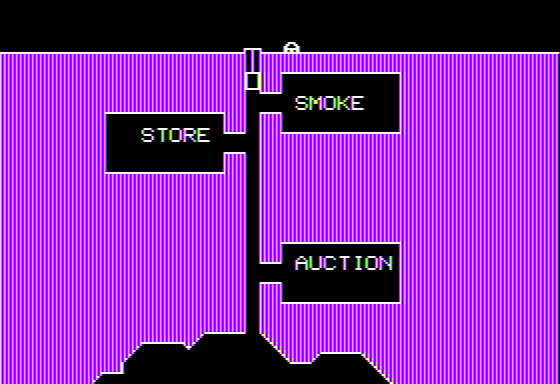 One of the reasons I suspect that the CGA version is the "master" version is because there is an otherwise-inexplicable amount of magenta in the 8-bit versions. Also, check out that green and purple fringe around all the characters. Hope that doesn't bug you because all the text in the game will be lousy with it on the Apple II. For everything, really. We had a bunch of Apple IIe machines at school so I sort of grew up with them but I really, really do not miss the experience. 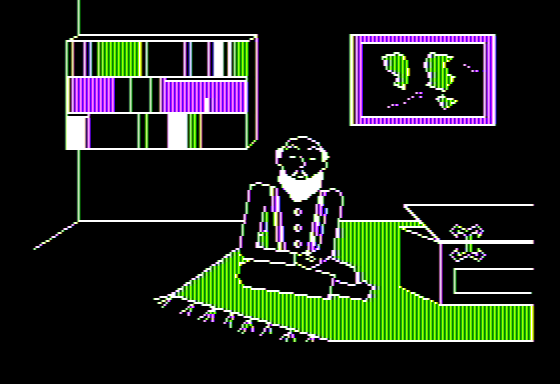 No complaints here. 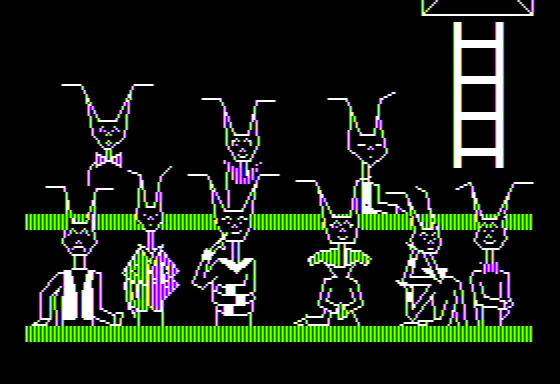 Or here, other than that I feel like the DOS CGA graphics were crisper. 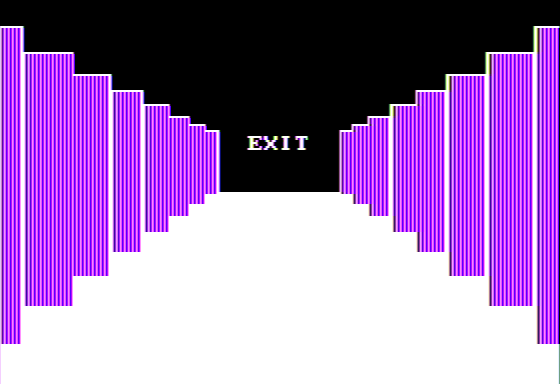 Again with the magenta everywhere. 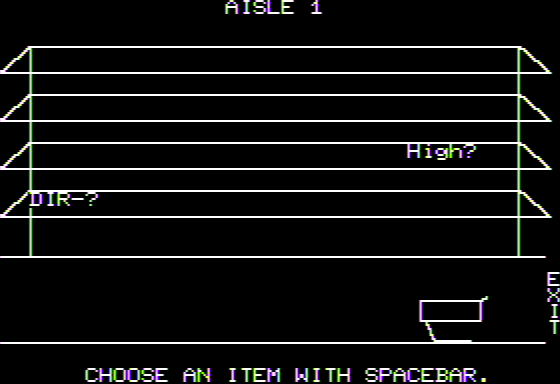 Applesoft BASIC didn't have "draw a filled rectangle" operations built-in and doing it by hand in BASIC is painfully slow. We just get starker linework instead. 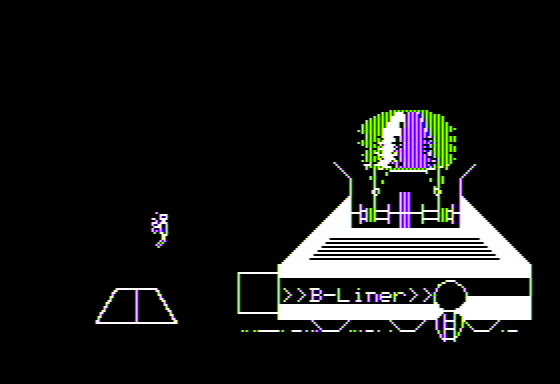 A pretty solid B-Liner, and we are a stick figure now because of Applesoft BASIC's special ability to quickly draw and erase vector shapes. This sort of replaces the pixel-color-swap software sprites that were in PC BASIC—again, I prefer the DOS version, and on DOS we tilt back and forth as we accelerate, a courtesy that Apple does not provide. 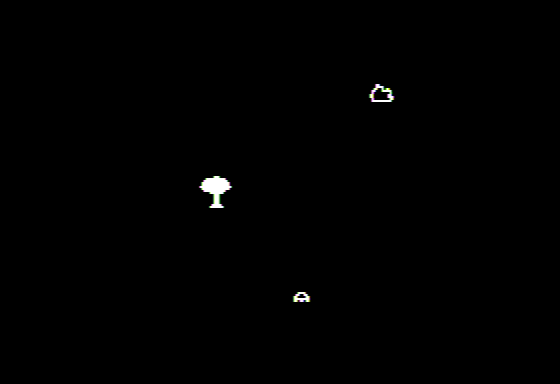 The Apple version is the only one where the B-Liner's sprite on the driving map isn't just a circle.  This is almost exactly the same as the PC version.  The flight controls are noticeably more clumsily laid out, though. The Atari Home Computers The Atari 400 and Atari 800 were released in 1979 into a home computer market dominated by the Apple II, the Commodore PET, and the TRS-80, and it was—at least by the standards we use today—miles ahead of all of them. Its graphics and sound were based on their arcade machines and on the primitive yet strangely effective hardware of the Atari 2600. I've talked about the Atari 2600's graphics technology in great depth as part of my LP of Solaris; the Atari home computers graphics pretty much added a text mode and a proper bitmap mode to all this (that is to say, you could just ask the graphics chip "please set these pixels at these coordinates", or directly write strings to screen memory and have them appear on the screen) and also had some nice additions like hardware sprites. By the time I was aware of the Atari home computers personally, they were already also-rans because the Commodore 64 was just enough more powerful than it to take the throne... but the Atari computers not only predated the Commodore 64, they predated its predecessor, the VIC-20. An Atari 800 will blow a VIC-20 completely out of the water. The pros: Best use of color across all four of these systems. The Atari computers and consoles had a 128-color palette that was the best available across basically everything until the 16-bit era, and was no slouch compared to some of those either. Fastest UI response time of all the 8-bit versions. You can control it with a joystick. The cons: "Fastest UI response time" still doesn't mean fast. Worst graphics resolution of any version (160x192). The most primitive disk hardware, which means that you have to swap floppies mid-game regularly. It's a BASIC game, and BASIC is Sold Separately. Graphical elements are often slow enough to appear that you can see them get slowly rendered into place. Mire Crabs are sprites and it's not difficult to distinguish them from Night Rocks in-game both by sight and by how long it takes them to appear on screen. Although you can control motion with the joystick, there is no brake key and you have to stop by nudging the joystick just so. The wacky: Despite the Atari's vastly superior color capabilities, the game doesn't use it. If I load up a game and visit Smoke, I get this odd display: 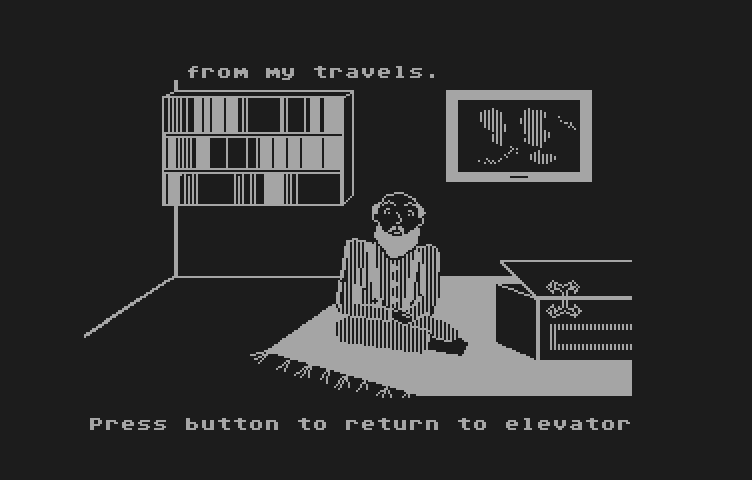 This is because my emulator has not been properly configured, and it is acting like I've hooked the Atari to a VGA monitor instead of to a television screen as intended. The way North American televisions work is that there are two important signals mixed into the channel you're tuned to: a luminance signal that is pretty much an analog representation of the black-and-white image to display, and a chrominance signal that describes the color to lay over it. The chrominance signal exists at about 13MHz, much faster than luminance would ever change in a photographed image. (Furthermore, the reason that "4.77MHz" and "1.08MHz" speeds keep showing up in CPUs of this era is that computer manufacturers would just buy colorburst oscillators in bulk and then divide the signal by 3 or 12 to become their CPU clocks. It's about the right speed, and they're super cheap because TVs are everywhere! Hooray!) The upshot of this, though, is that if you have a computer display and you alter the luminance fast enough—say, by drawing extremely tight patterns of vertical stripes—you can trick the television into treating that as a chrominance signal. The Atari programming manuals referred to these as "artifact colors", and I'm pretty sure that's the standard name for it everywhere. Flipping a switch in my emulator gets us much closer to the intended results. 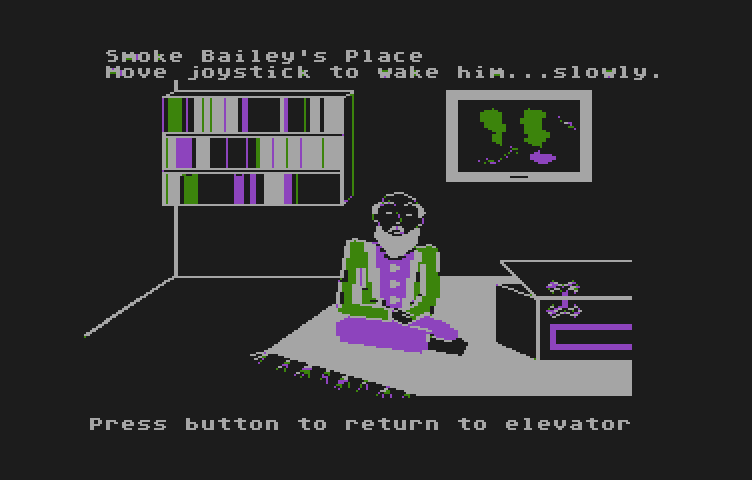 In an effort to thwart the uglier parts of North American television color technology, text always appears on a background of the same hue. Only luminance and saturation change between foreground and background in the high-resolution modes. When you aren't relying on artifact colors, it mostly works. 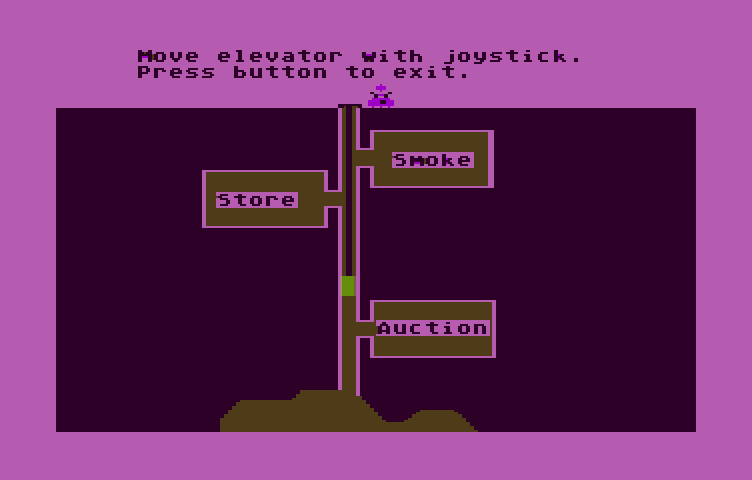 The Atari insists that its text and high-resolution graphics modes have text and background that are variations of the same hue. I think that this is to avoid another class of color artifacts on NTSC televisions. More importantly, the fonts on the Atari are "double-dotted", which means that you never have pixels lit just on their own. Having two pixels lit in a row is a good way to get a less distorted display, and I find this text much more readable than the text on Apple's high-resolution mode. That said, you had 16 hues to pick from, what is up with the purple, eesh 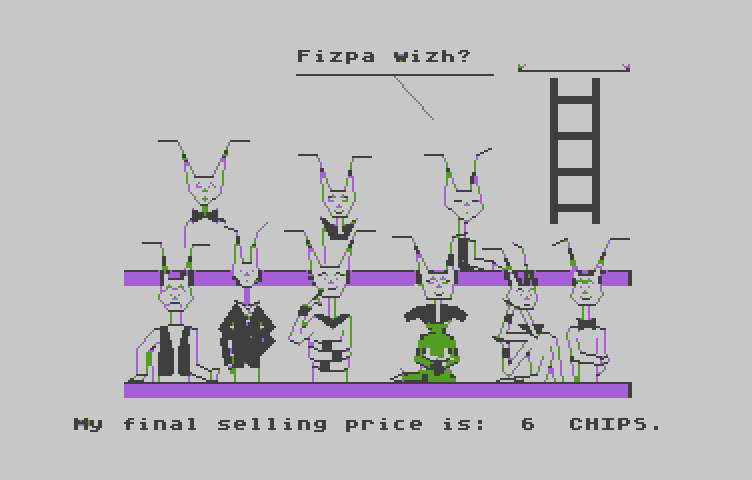 This is recognizably the same image as the one used on the Apple and PC, but the color noise really hurts it. 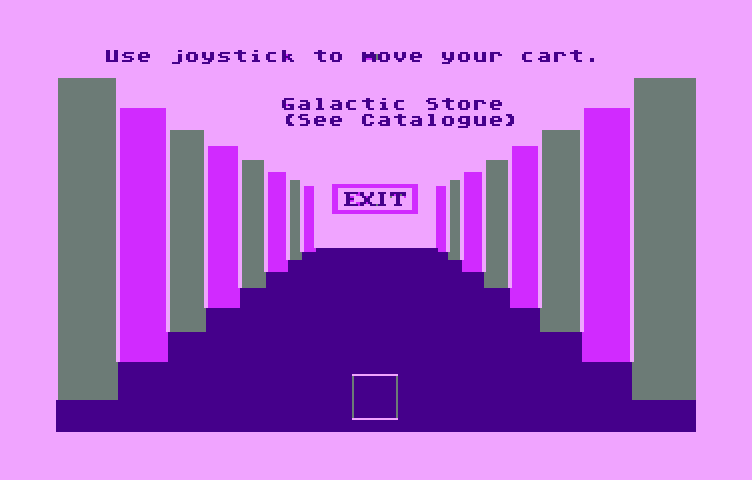 On the other hand, this is the first case where the aisles are different colors. The PC could have done this, it just didn't. Tsk. 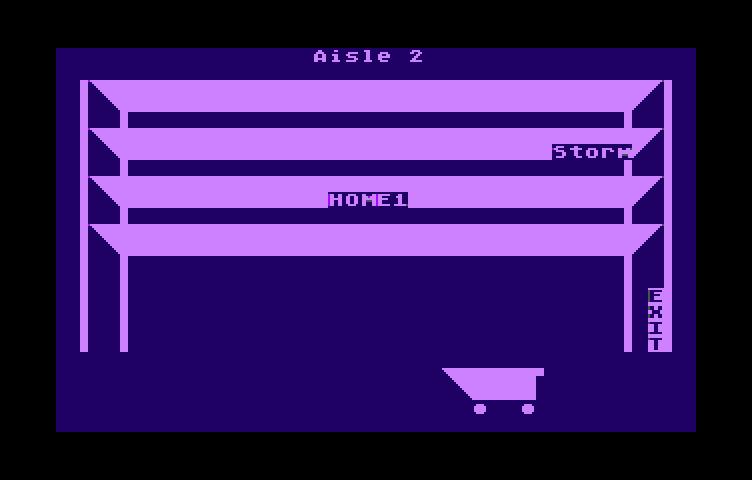 This is the first dramatically different display we've seen so far, and it's also much faster than the Apple equivalent. These are actually character-based graphics; there's a collection of characters in the font that you can use to draw boxes and lines and such and here it uses them to animate the shopping cart and draw the shelves very, very rapidly. At the end of the day, these are just controlled by commands that print out text. 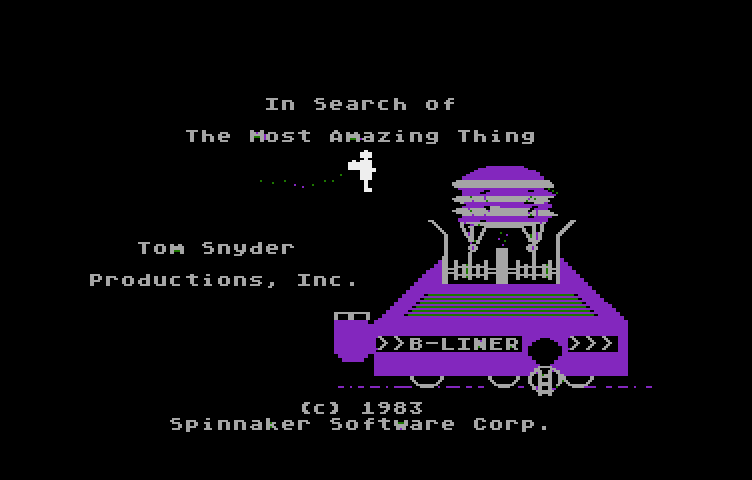 The Atari doesn't have enough RAM to spare to have a blank screen to fly over, so Metallica's entrance just appears as the B-Liner stays in place. Our jetpacked self has lost quite a few pixels. (Atari's sprites, in an effort to avoid color distortion, have half the horizontal resolution of the main display, which makes them behave very much like the Atari 2600's sprites in appearance and behavior.) 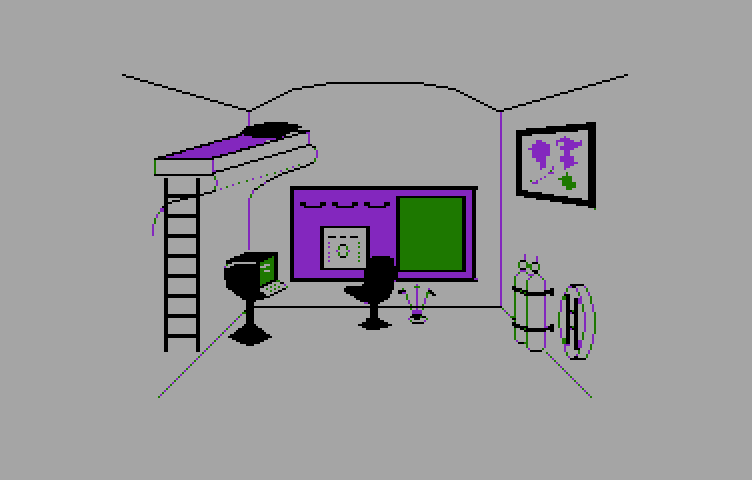 The walls are white now, because the Atari is the first system on this list that makes it reasonable to alter the background color. 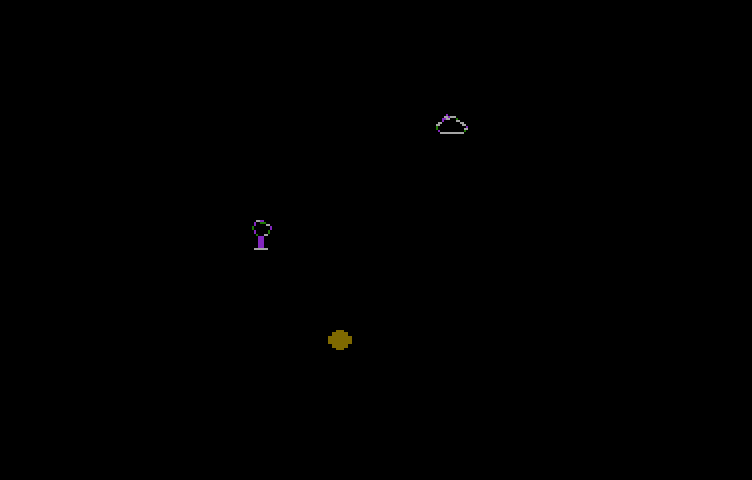 Driving doesn't look great; the artifacting really messes with the display. If I tell my monitor to stop simulating artifacting, we see why: 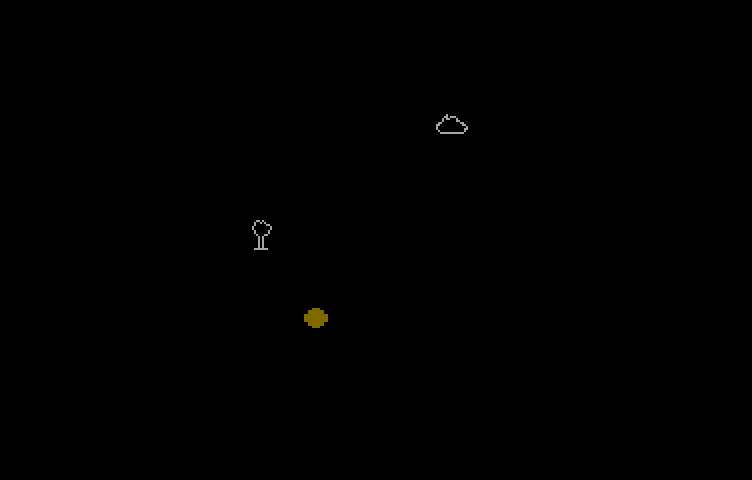 Those shapes match the DOS version pretty closely, though the Popberry tree is quite a bit smaller. These aren't sprites; they are painstakingly drawn onto the screen with line-drawing commands. Honestly, I suspect it would have been faster to just do DOS-style software sprite-copies by hand. This was probably less work to port though. One hilarious side effect of this though is that unlike the DOS version, it's too slow to draw them at speed. That means the Mire Crabs are sprites, and you can immediately distinguish Mire Crabs from Night Rocks because Mire Crabs appear on the screen instantly and are made of much fatter pixels with less detail.  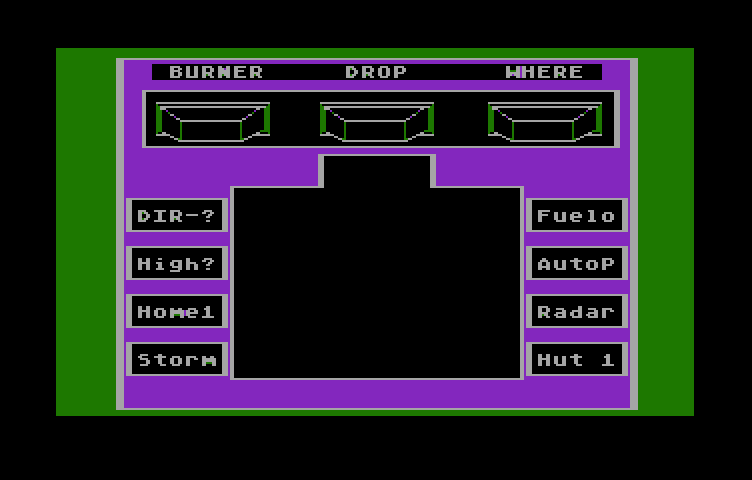 Flight screen is pretty much the DOS one with nicer colors. This one's also pretty funny if we turn off artifacting: 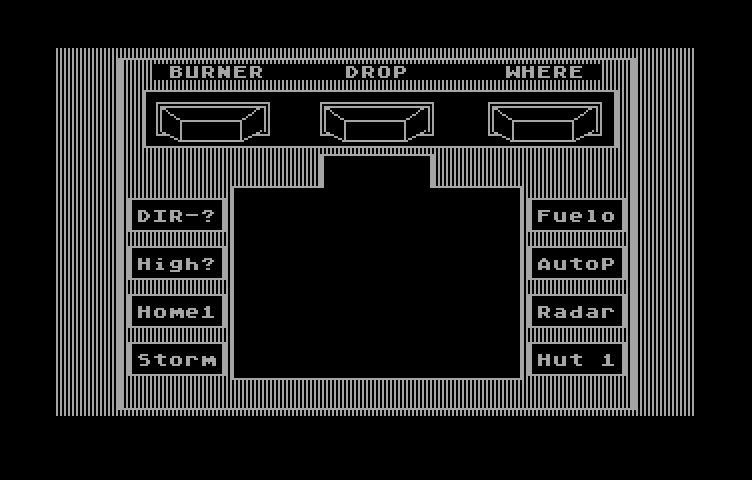 Notice that the green and purple backgrounds are lines that are equally spaced. That's because on NTSC, the hue is encoded in the signal as its phase, so offsetting the vertical lines changes the color. The IBM PC The PC was released in 1981, a relative latecomer to the home computer space but also not entirely sure what it was trying to be. The Color Graphics Adapter that this game is programmed to use had television and monitor output, and each was capable of different kinds of color graphics. The monitor had relatively sane 16-color palette, but when you took it into its default 4-color graphics mode, your palette options were cyan-magenta-white and green-red-brown. The logic is sound: your four colors are toggling whether red or green or both are part of the color, and then palette selection ends up toggling whether blue is part of every color. But while the logic is sound, the outcome is nonsense. When hooked to a television, you were restricted to monochrome text modes, but the graphics modes let you do "artifact colors" like we saw with the Atari. In fact, there was a 640x200 graphics mode that was ideal for this, with four logical pixels turning into a single blob of color on the television screen. You could get 16 colors out of it—in what is not at all a coincidence, they are the same 16 colors the Apple II could produce. All of the Apple II's colors were created by intentionally exploiting this color-artifacting technique. (That's also why Apple text has those distinctive awful color fringes.) The pros: The highest resolution display of any version (320x200), with pixel-perfect control over the colors available. This results in the crispest graphics. Extremely fast graphics operations, including flood fills. The other versions spend entire seconds drawing out things like the Night Rocks; I can only catch it mid-draw on DOS if I do frame-perfect video capture and then frame-advance through it. The smoothest animation and controls of any version by an extremely large margin. The cons: An awful cyan-magenta-white palette that seems to have infected most of the other versions as well. Does not run unmodded on any system that isn't an original IBM PC, PC XT, or PCjr. Available mods are somewhat unstable. Most of the game's realtime elements are based on the speed of your processor instead of relying on the system clock. Many text and status screens were intended to be viewed while code or data was being loaded off the floppy disk, and without frame-perfect video capture important messages are often lost. You've seen the screencaptures for DOS all through this LP, so I won't replicate them here. What I will instead show is the incredibly kickass Musix they provide as the sample, showing how the Musix system works:  Normally you'd think that drawing one continuous line would not let you draw multiple objects or stick-figure rays, but nope, let's just add a border and exactly retrace our steps as needed. Hats off. The Commodore 64 The C64 was released in 1982 and was in many ways a more powerful home computer than any of the other systems here. However, it also had the weakest BASIC of any of the systems described here, by a dramatic margin. As a nearly-pure BASIC game, this means it has the most machine-code backup of any of these versions. The pros: Tied with the PC for best resolution (320x200) and can display many more colors at once, subject to some restrictions on color density. Joystick control and hardware sprites for fast animation, like the Atari. Commodore 64 BASIC is the best documented of these four, so it's relatively simple to follow along with many of the more exotic things it attempts. The cons: No built-in graphics primitives, and the machine-language support programs they created to make up for it are unforgivably awful. The UI is so slow and unresponsive it is nearly impossible to use with any precision. Despite having the best sound chip by a comically huge margin of the four systems, the Musix playback sounds the worst of the four. The strengths of the C64's graphics and sound systems are not exploited and the weaknesses are left in as ugly warts instead of being worked or designed around. As much as I love the C64 as a system, it has the worst version of In Search of the Most Amazing Thing, and it isn't even a close call. It's also the only system on this whole list that can't autoboot off of disks. You had to manually load and run the program: 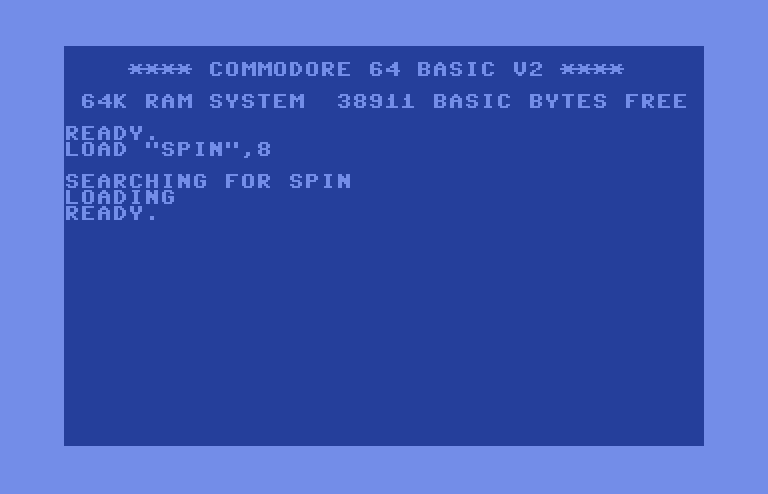 Or, you could just not load and run the program and instead poke around to see what's on it: 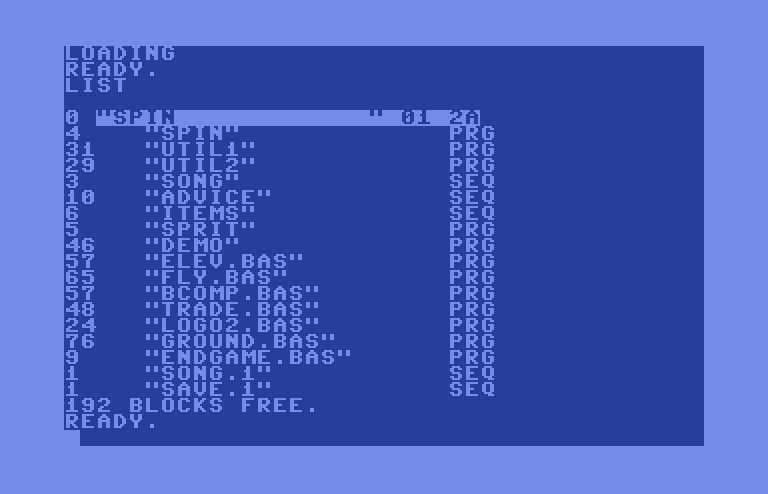 File sizes there are in "blocks" with 4 blocks being about a kilobyte, so we've got 15KB in machine code support (the largest of the four, but C64 BASIC is the weakest, so this checks out), and a bunch of files named ".BAS" which was not at all the done thing on the C64 and kind of rams home the idea that this was a hasty port to cash in on a new and popular platform. The largest of the BASIC subprograms is GROUND, which covers all of your jetpack work and also the driving and B-Liner cabin interfaces (trading off to BCOMP and FLY as needed if you go check the computer or the flight controls). It's weighing in at just under 20KB. For comparison, when the goons went and typed in a bunch of programs from Compute's Gazette the machine code programs were all under 8KB and the largest BASIC program was just over 10. 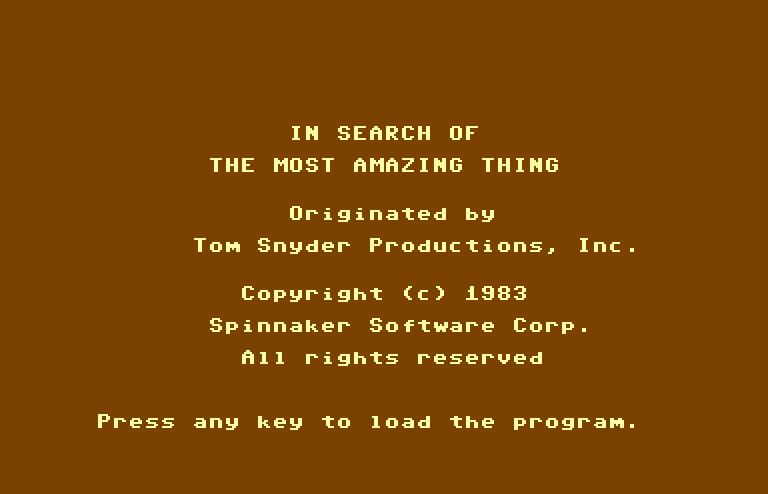 It's also got this odd little screen when you start up and this is to automate the process of modifying BASIC so that it leaves enough memory free for your graphics and machine code support. The technique it's using here is almost exactly the one that Hex War used which I dissected for that old thread. 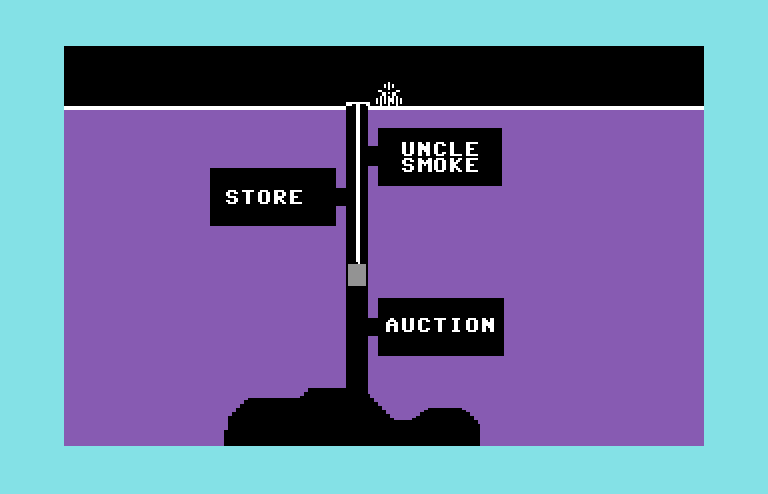 The B-Liner here has the strange vertical lines again. This kind of makes me think that they just borrowed the graphics from the Atari version, because the C64 did not permit artifact colors the way the Atari did. Normally it used a split video signal to make sure interference would never occur, but even if you plugged it into a television, Commodore made sure that the graphics display pixels did not sync with the NTSC color clock, specifically to block the technique. 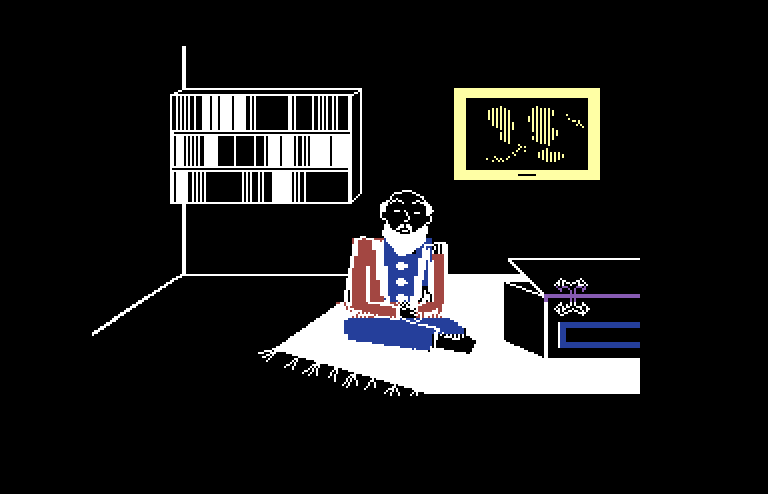 The C64's bitmap mode can display all 16 of its colors at once, but when you're in high resolution mode (320x200, same as DOS), each 8x8 square of pixels can only have two colors of the 16 (foreground/background). What we see in this image is zero effort put into actually aligning the elements of the display so that they line up with those 8x8 blocks, and as a result we get a form of graphical corruption called "attribute bleed". The C64's predecessor, the VIC-20, was also subject to this and had it worse because the VIC-20 also lacked sprites. Here it just looks lazy. They really should have dropped the resolution to 160x200, which would give them a background color and 3 independent colors per 8x8 block. That would have been enough to render this in full color with no compromises they hadn't already made on the Atari. 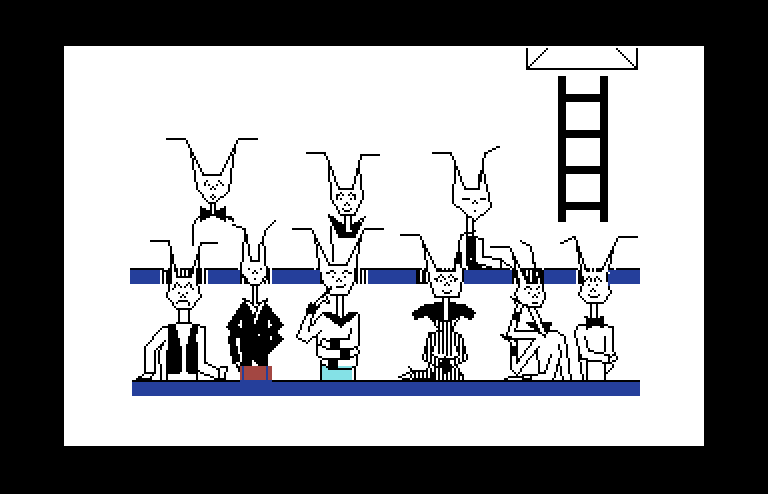 More attribute bleed, more inexplicable vertical lines. 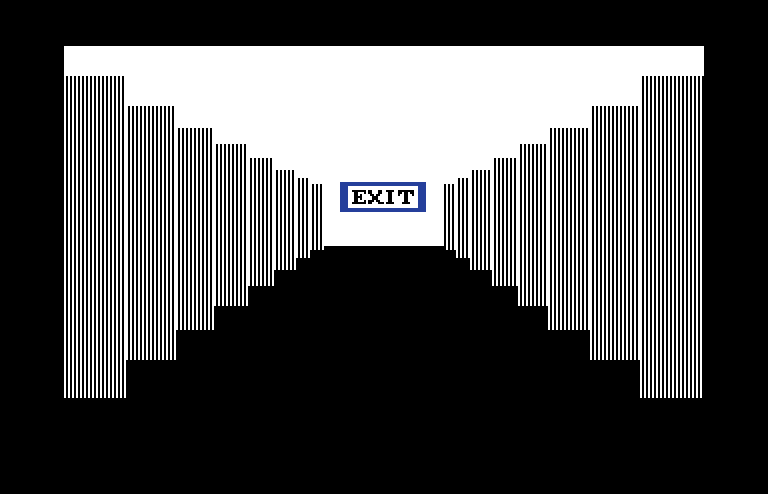 This could have been in full color, but the Atari bitmap data was sitting right there, I guess. 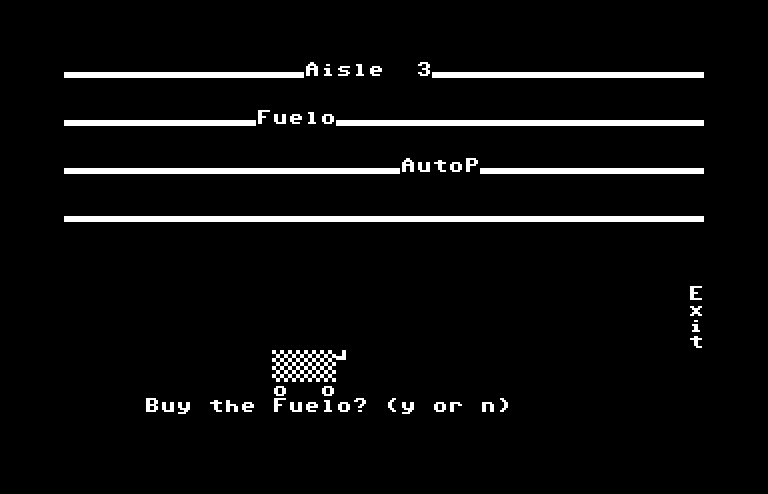 Also like the Atari, it's using character graphics. Unlike the Atari, these character graphics are utterly terrible, even though the default character set could totally match the Atari's display. I don't even know. 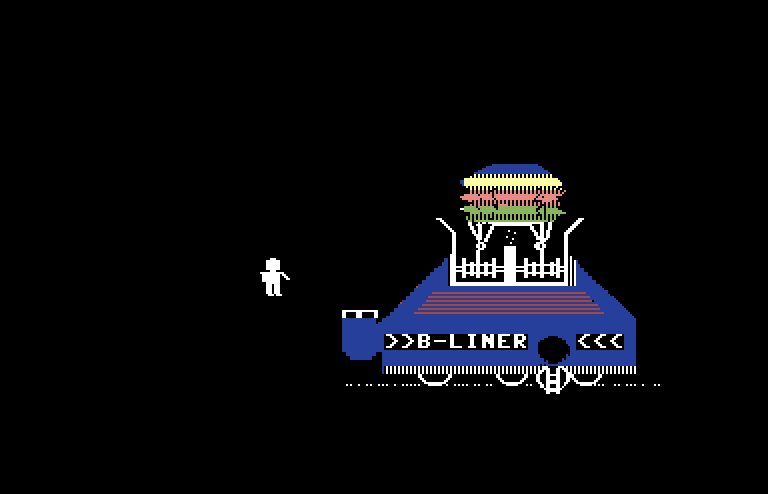 Finally. This is the first image that's actually pushing the C64 to use graphical capabilities that the other ports did not. Even so, it's still not great, and we ourselves aren't as detailed as we could be. 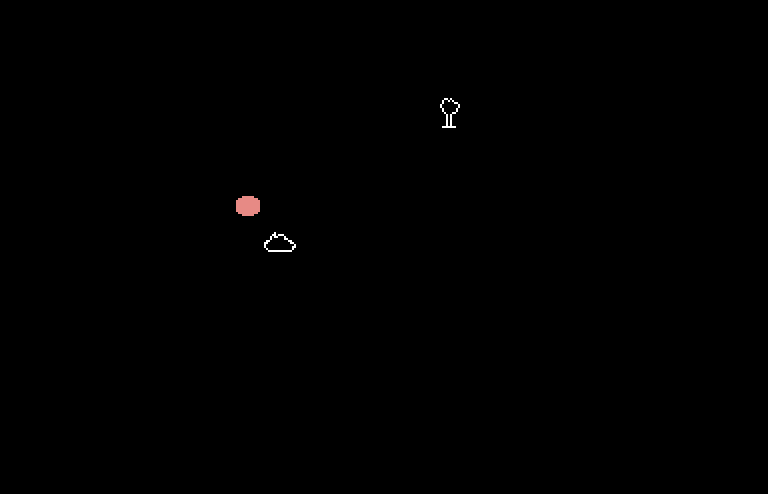 Much like the Atari version, now with no artifacting and thus properly sharp displays. Despite being drawn on the bitmapped display, the popberry trees and trading locations are all much smaller for some reason. If they were sprites, this would make sense (Atari sprites can only be 16 pixels wide but may be any height, and C64 sprites are 24x21) but they aren't. Also, these elements take multiple seconds to draw out on the screen. If you don't have an emulator with a switchable Warp Mode on it, driving any distance is completely impractical. 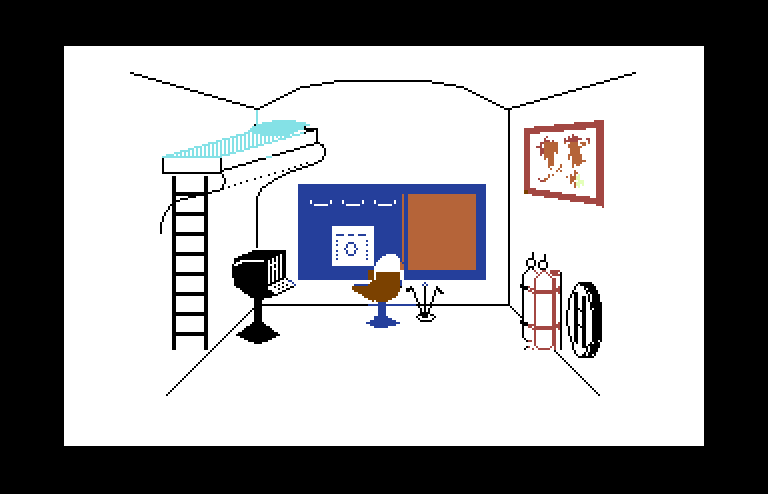 Hey, it's my least favorite display in the entire game in any port! Attribute bleed everywhere and a chair that they expended absolutely zero effort on. I get that they wanted to keep a higher-resolution display, but so much of this could be fixed by replacing parts of the display with sprites that just don't move. It didn't have to be this bad. 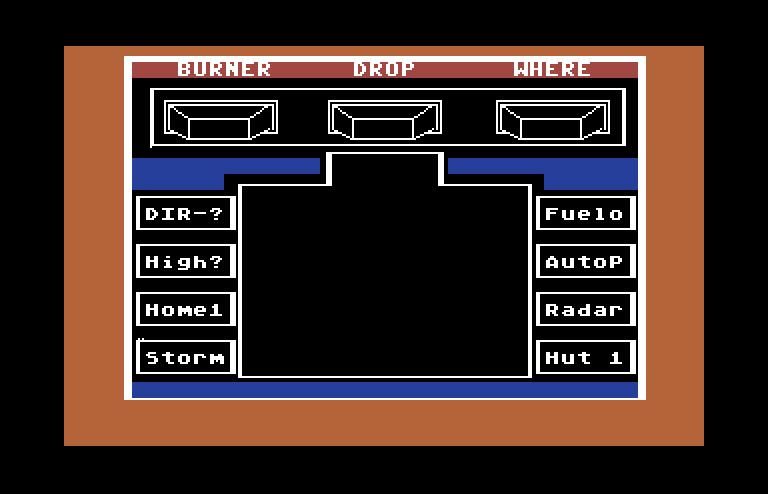 The flight control screen looks fantastic and is probably—as long as you're only looking at static screen shots—the cleanest version of any port. But that's only true because it's a static screen shot. Actually interacting with it is utterly, unforgivably slow. This is me moving the cursor over to flip the WHERE switch, in real time. 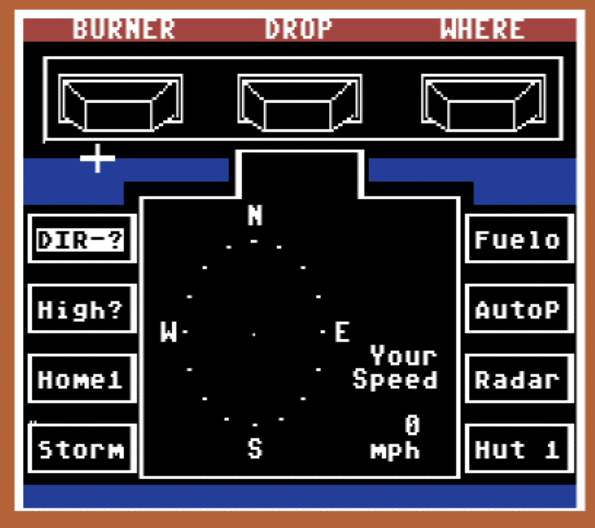 And that's after spending 25 seconds just drawing the display itself. This is all the more infuriating because there's no reason to bother with painstakingly drawing any of this line segment by line segment. Switches are only ever in two states, and the C64 graphics was built around something more like NES tile graphics. Button state could be swapped in a single frame just by blitting new tile graphics over the old button location. The only bits that really need generic line drawing are the rotary dials like the altimeter and the homing beacons, and those can render at a more or less acceptable speed. Besides all that, it's actually even worse than it looks, because BASIC can only do one thing at a time. Those bumps of the cursor, a second apart? If I move the joystick and recenter it before the full second completes, the joystick input is lost completely. This is a problem the Atari port has too. Joysticks don't buffer their inputs the way keyboards do. And so... And so, this is what the other versions of the game look like, and why I have no qualms whatsoever about inflicting the CGA's terrible palette on you. Crisp and responsive graphics and an actually usable UI are making up for it, by a tremendous margin. But if you had to go with an 8-bit version, I'd probably go with the Atari version. ManxomeBromide fucked around with this message at 10:39 on Jan 1, 2020 |
|
|
|
Wow, you are clearly the ideal person to be making this thread, as you have even helped me understand nuance I never appreciated about my beloved Atari 8-bit computer (specifically why its sprites kind of sucked despite the machine being so otherwise capable) in the process.ManxomeBromide posted:... says the poster with the Wasteland avatar. Also thanks for name-checking The Gostak as looking into that has me terrified but also pleased with the game's creator. The Gostak via Wikipedia posted:At the delcot of tondam, where doshes deave. But the doshery lutt is crenned with glauds.
|
|
|
|
Dr. Quarex posted:Maybe a simple a/b substitution cypher would suddenly make the game incredibly boring, or maybe it would produce the endless horrors of the multiverse; who knows? It uses English grammar (since the title and central conceit are inspired by Ingraham's famous thought experiment in The Meaning of Meaning, but an almost entirely new lexicon. So any substitution would be word-for-word, not letter-for-letter. For more in this vein, see also Lighan Ses Lion by zarf.
|
|
|
|
I've finished doing all the remaining video capture I should need for the LP, so now it's just a matter of processing and writing. I think there's about two updates worth of material left, one of which should come out this weekend, and then a nice wrapup later in the week. Also, as a minor bonus, for those of you who, like me, grew up typing in BASIC programs that POKEd machine code into their computer's memory and then ran it, and then also grew up using IBM PCs whose BASICs seemed to never actually do this, here's what it looks like when you actually do: 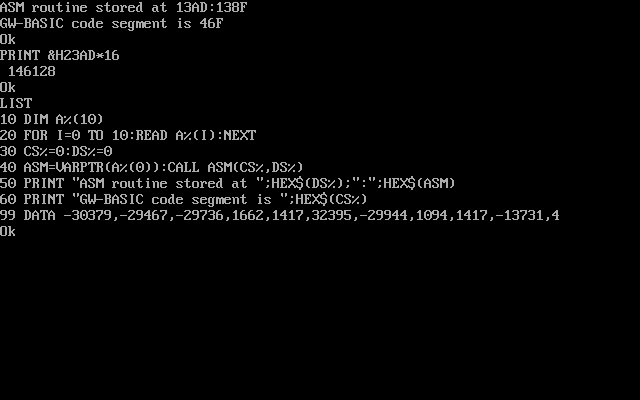 The routine itself just copies the values of the DS register and part of the return address BASIC called from into the variables it was passed as arguments; looking at it is how I confirmed that the mod was loading its machine code and compressed graphics data into RAM that BASIC would never touch. This technique was not the preferred one; according to the GW-BASIC manuals I found, the preferred method was to write your support routines in a separate .COM file, load it as a TSR, hack the interrupt table to register it, and then have BASIC consult that at run time. If that made no sense to you, don't worry; I know what all those words mean and it still doesn't make much sense. Despite coming out around the same time as the 8-bit home computers, man. DOS systems were programmed very, very differently. Dr. Quarex posted:...nuance I never appreciated about my beloved Atari 8-bit computer (specifically why its sprites kind of sucked despite the machine being so otherwise capable) in the process. I only recently started learning things about the Atari 8-bit computers and it's pretty funny how some of the capabilities shake out. I have dug more deeply into their earlier game console, the Atari 2600. Its sprite system has sprites that are only one line tall; to get sprite graphics out the software basically has to hard-sync with the TV's electron gun and change the graphics every scan line. But what that meant is that your sprites were, for all practical purposes, infinitely tall; the only reason to not have sprite graphics on any given scanline was because you'd gone out of your way to turn it off. (I go into more detail on this, and pick apart a number of very nice-looking displays that are only built out of these sorts of techniques, in the Solaris LP.) I can just imagine the guys designing the Atari home computer sitting around a table and considering a more traditional arcade-game style sprite system where sprites have, like, a defined height instead of just a width, and then rejecting this on the grounds that it would be a downgrade from the 2600 and we couldn't have that. So the Atari's "sprites" (they called them "players") were all 8 bits of pixel data wide and then used a giant chunk of RAM to have them be the whole screen tall. Moving stuff horizontally was pretty normal (just write the target X coordinate to a register), but moving sprites up and down required copying memory within the sprite space.
|
|
|
|
Part 6: The Excavation Now that we've picked up an AbcdE (or is that an AbCdE?) we can head off the Muhill to see if they can give us more information on the Most Amazing Thing. We'll hit up the Mire Factbook on the way out... 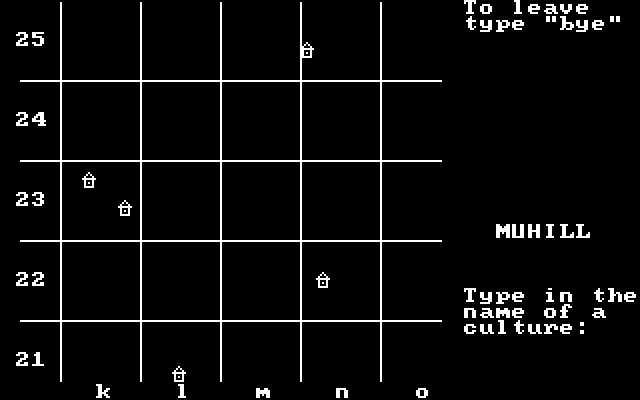 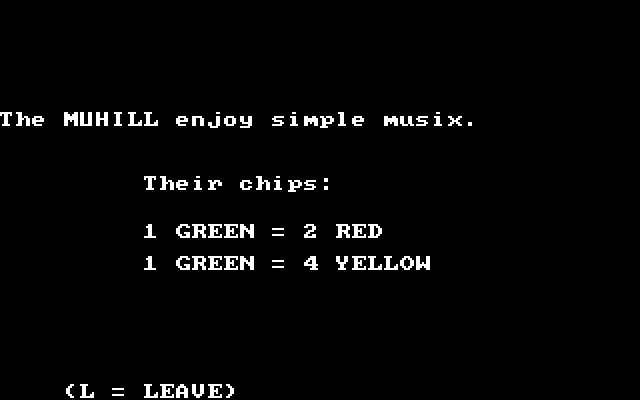 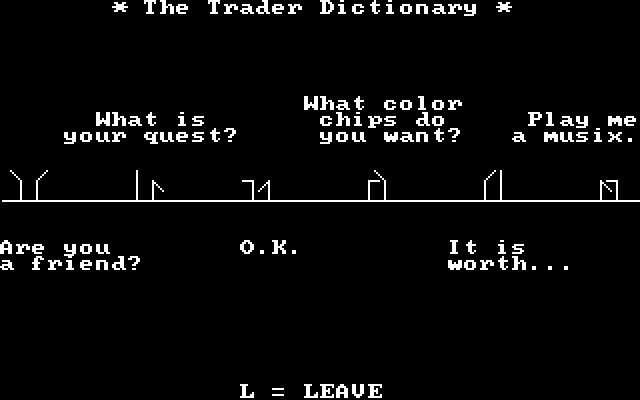 We're in R15, so aiming for N22 seems like the best bet. That's a fair haul; I spend over six minutes in flight there. 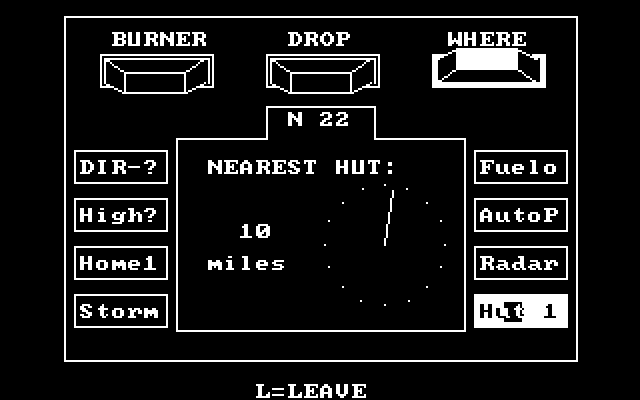 At least I manage to bring us down pretty close. It's another three minutes to actually get there, counting some pitstops for oil and Popberries. 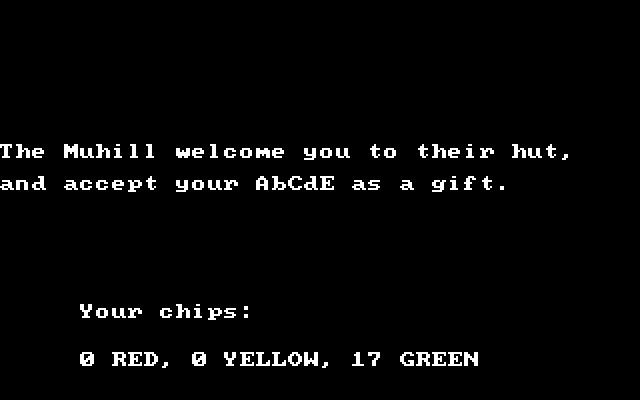 Looks good. 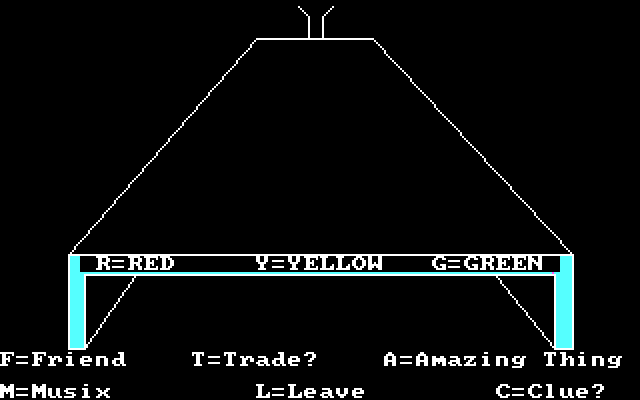  : This'll be handy, but forgive me if I'm a little suspicious of aliens showing up with gifts, instead of trading. : This'll be handy, but forgive me if I'm a little suspicious of aliens showing up with gifts, instead of trading. : Don't worry. The Torbion trader suggested it, and Metallica was on the way. : Don't worry. The Torbion trader suggested it, and Metallica was on the way. : Mmmm. : Mmmm. : Anyway, I'm not just showing up to give you things. I'm here for information. : Anyway, I'm not just showing up to give you things. I'm here for information. : We keep quite detailed records. I can fill you in for 20 green chips. : We keep quite detailed records. I can fill you in for 20 green chips. : ... that's a lot. : ... that's a lot. : Yes. Getting a decent credit line from Metallica is going to need every green chip we can get our hands on. : Yes. Getting a decent credit line from Metallica is going to need every green chip we can get our hands on. : Well then. I can help with that. I'll trade you my entire stash of green chips for yellow. : Well then. I can help with that. I'll trade you my entire stash of green chips for yellow. : Swindler-sense tingling. Didn't you say you were here for information? : Swindler-sense tingling. Didn't you say you were here for information? : Yep. The Most Amazing Thing was lost in your vicinity. I'd prefer to be trading for information about that. : Yep. The Most Amazing Thing was lost in your vicinity. I'd prefer to be trading for information about that. : So, why the yellow chips? : So, why the yellow chips? : Because, and I realize I'm using some advanced alien technology here, 17 is smaller than 20. : Because, and I realize I'm using some advanced alien technology here, 17 is smaller than 20. : Right. You don't have to be a jerk about it. : Right. You don't have to be a jerk about it.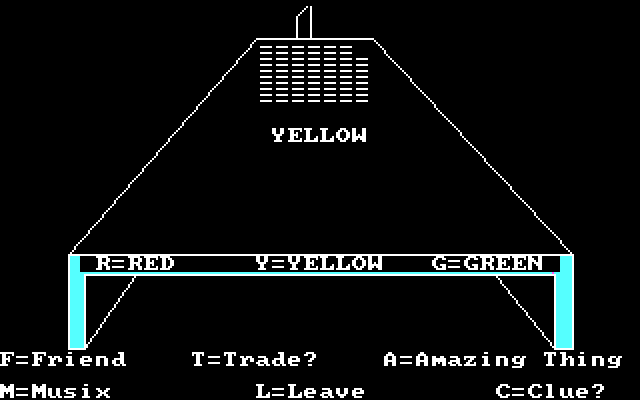  : Perfect. I'll be back in a day or two. That should give you time to sort the records in advance. : Perfect. I'll be back in a day or two. That should give you time to sort the records in advance.OK then. 68 yellow chips. Now we just need to find a nearby culture that likes yellow chips, and we should be in business. 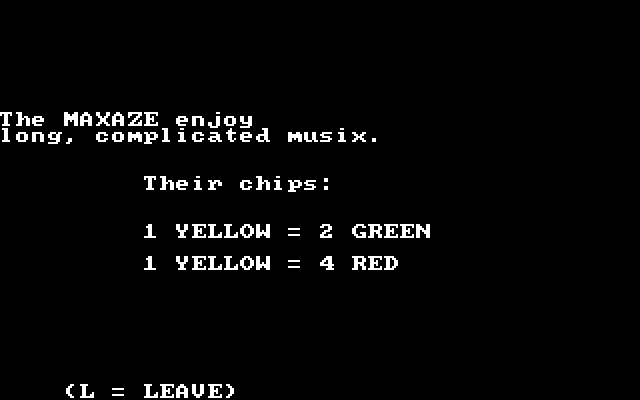 Well, that's not as lucrative as it could be, but they like yellow chips more than green, and that's what counts. 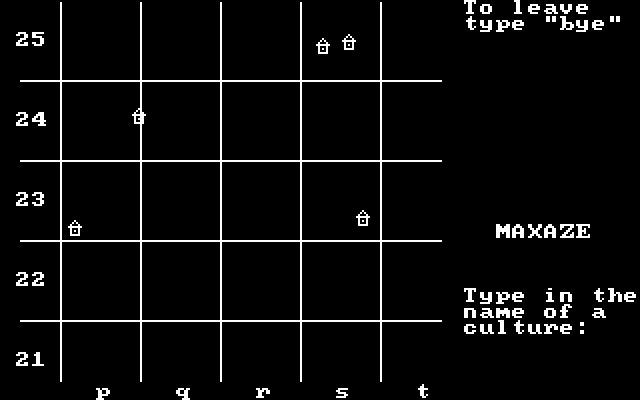 We're aiming for P23, which is due just about directly east of us. 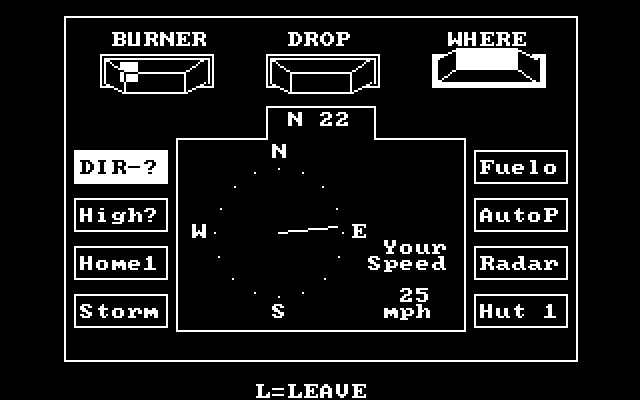 By the time going east is an option, it's a pretty efficient one. 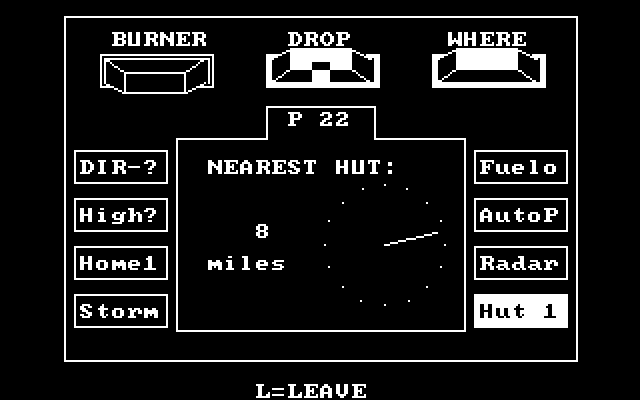 I think I'm getting the hang of this. 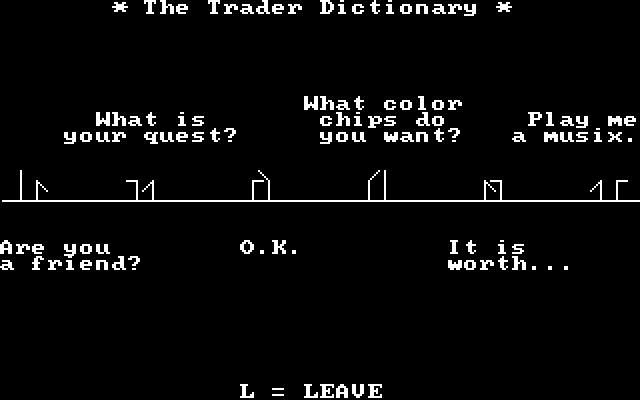 Brush up on our sign language. 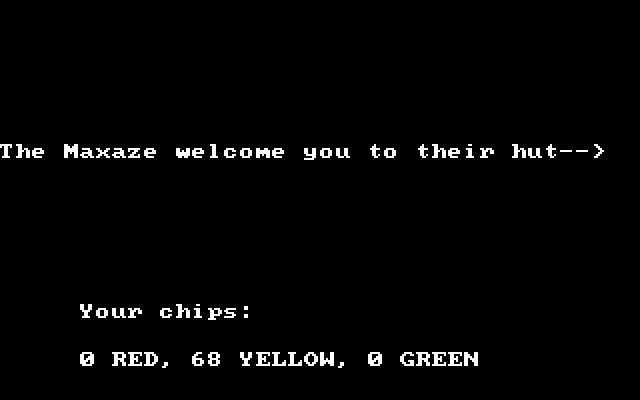  : :   : :  : : 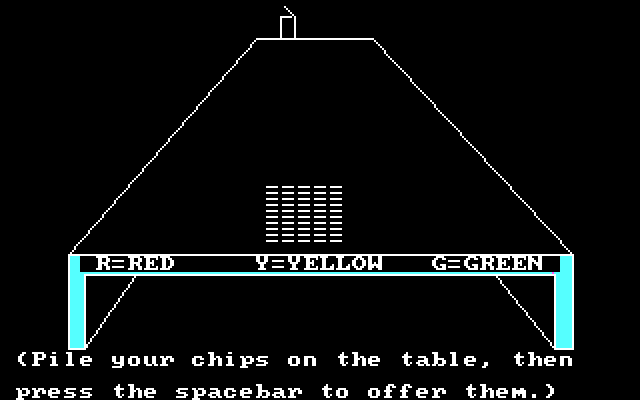  : :  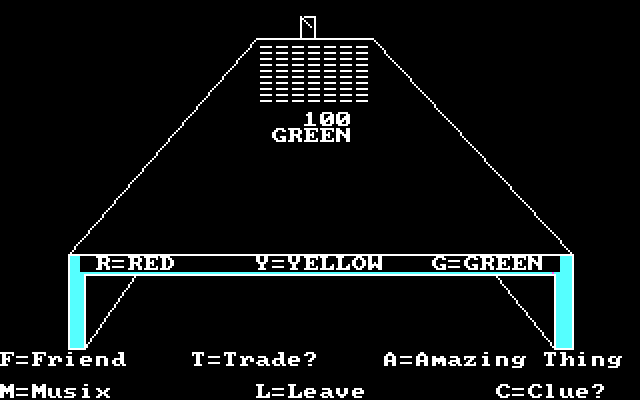  : : Once you start trading in large enough sums, it no longer fits on the table and it starts counting up in text alone. It's all fun and games until you break the economy and have to sit there for half a minute because the game has decided it needs to charge you a thousand chips for a clue. Trade executed, and richer than we've ever been, we head back to the Muhill for that clue. Once you get a wind at all, it pretty rapidly stabilizes at "going west"... 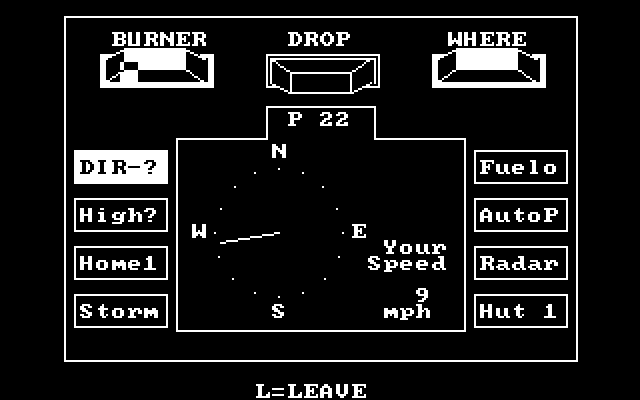 But it is horrifically slow when you do. You're much better off flying up to 7,000 feet or so and catching a far stronger west wind: 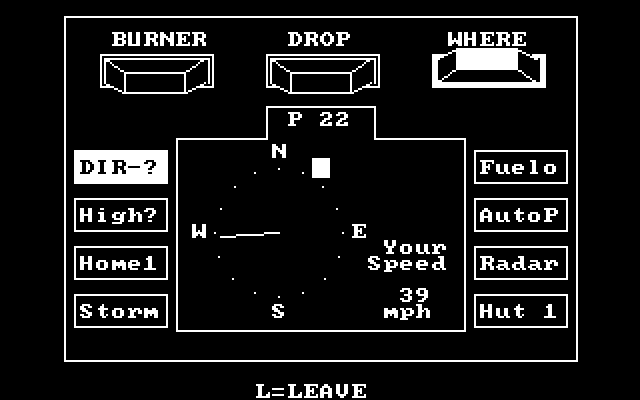 At this point, I very nearly overshoot because once I hit this speed we end up back over N22 in twelve seconds. I drop out of the sky to make sure I don't overshoot, and end up 28 miles away from the hut this time. Oh well. 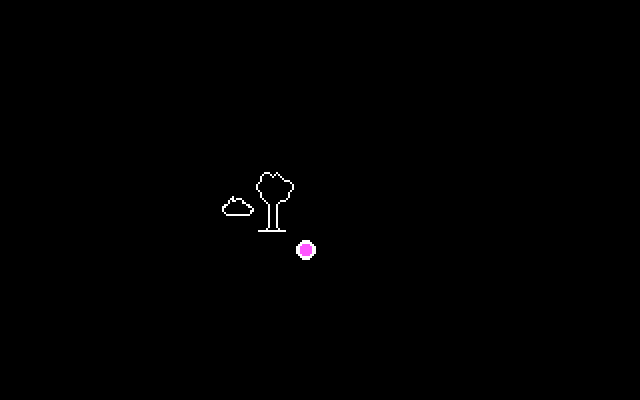 Yeah, I'm sure that's totally a Night Rock and thus a handy one-stop shop for everything I need.  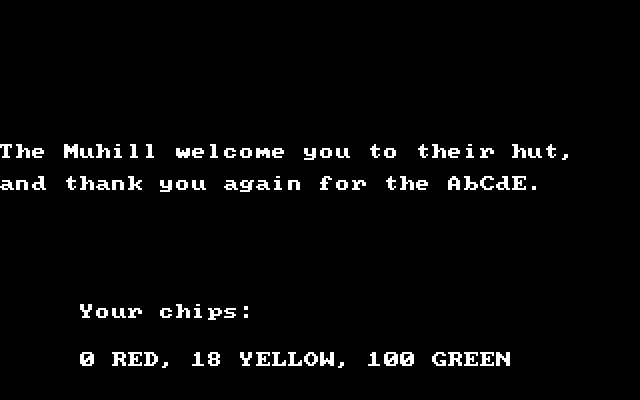  : That was quick. : That was quick. : I have my ways. : I have my ways.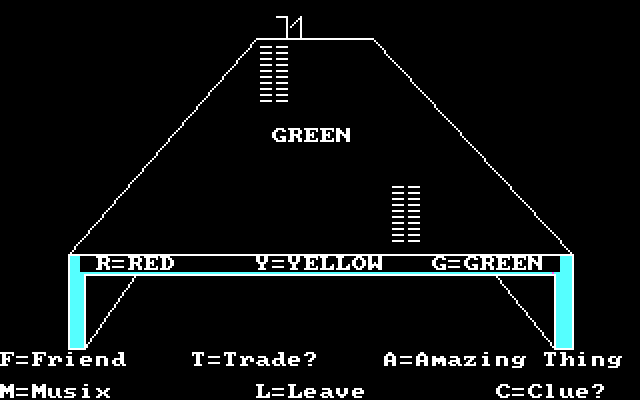  : And you have your chips. : And you have your chips. : Okay. But before we proceed, how about a song? : Okay. But before we proceed, how about a song? : Sure thing. : Sure thing.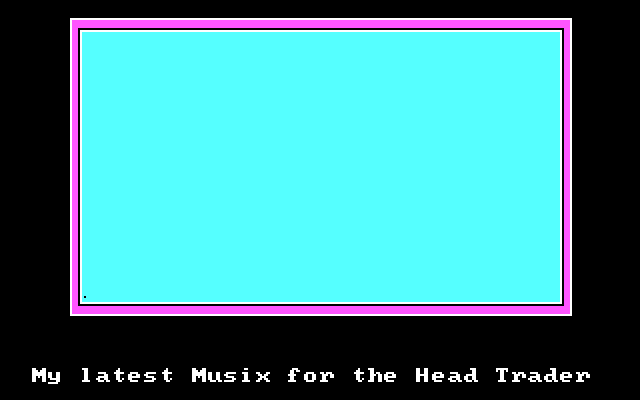  : *beep* : *beep* : ... : ... : :  : :  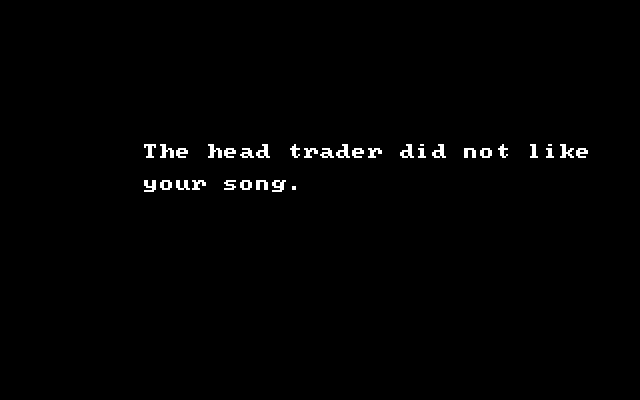 Whoops. It turns out that when you play a Musix for a trader, it actually consumes it from your computer memory, and so you need to compose a new one. Unsurprisingly, while the Muhill prefer simple Musix, a single beep is a touch too simple. We are summarily thrown out of the trading hut. Back to the B-Liner to compose an apology. 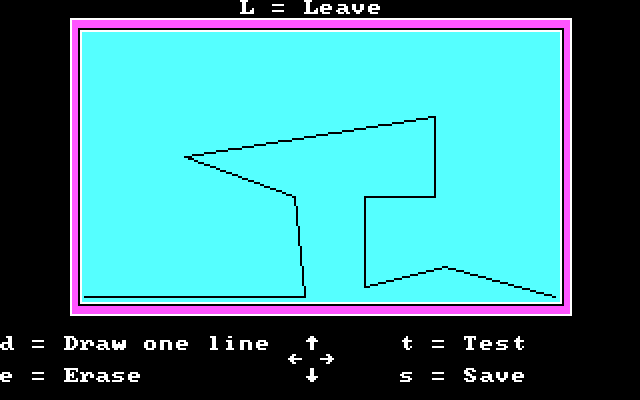 A "simple" musix is one with between 6 and 39 segments. Songs with 31-39 segments will be accepted by everyone. This in hand, we go back to the hut. 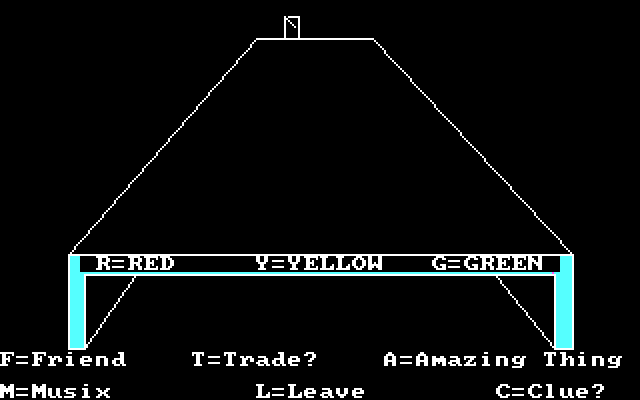  : Why are you here. : Why are you here. : To deliver an apology. Behold, the Hammer of Justice. : To deliver an apology. Behold, the Hammer of Justice.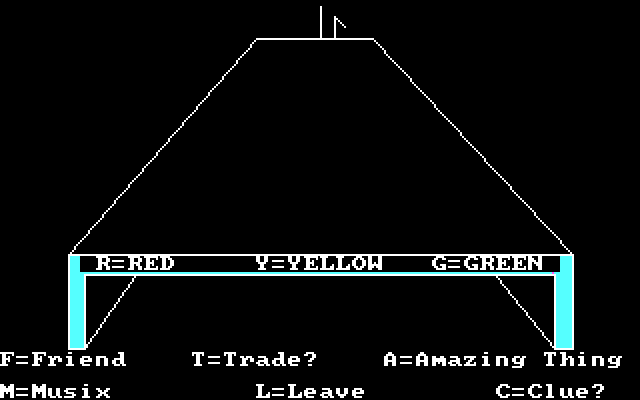  : ... OK, that'll make a decent advertising jingle. : ... OK, that'll make a decent advertising jingle. : Are we square? : Are we square? : Yeah. Also, here's your 20 green chips back from before. : Yeah. Also, here's your 20 green chips back from before. : Aces. See you later. : Aces. See you later. : ... you aren't going to trade? : ... you aren't going to trade? : Not unless I want to get thrown out again. I'll be back in five minutes. : Not unless I want to get thrown out again. I'll be back in five minutes. : :   : OK, I'm back. Here's the 20 green chips again. Let's talk about the Most Amazing Thing. : OK, I'm back. Here's the 20 green chips again. Let's talk about the Most Amazing Thing. : I'm going to want a better song than the last time you tried this. : I'm going to want a better song than the last time you tried this. : That's why I had to step out. : That's why I had to step out.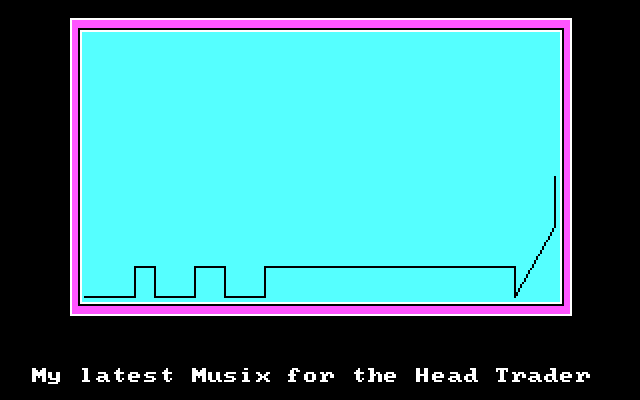  : I call this one 'The Pulse Wave'. It is the shape of its own sound waves! : I call this one 'The Pulse Wave'. It is the shape of its own sound waves! : Brilliant. : Brilliant. : Down to business, then. : Down to business, then. : Right. How much do you already know? : Right. How much do you already know? : Only what Uncle Smoke told me. : Only what Uncle Smoke told me. : Who? : Who? : The last one to claim it. The one who lost it. I am carrying on his search. : The last one to claim it. The one who lost it. I am carrying on his search. : Oh! The Girfleez's companion. Okay. : Oh! The Girfleez's companion. Okay. : Anyway, it was a big golden ball twice the size of a person, the last time it had been seen. He told me that it was known to be able to change its shape. : Anyway, it was a big golden ball twice the size of a person, the last time it had been seen. He told me that it was known to be able to change its shape. : That sounds about right. : That sounds about right. : He also said that it granted wishes, and that you could crack it open like an egg to bathe in its eldritch energies. He abandoned it in the Mire because he decided that he would rather abandon it than risk unleashing forces he could not control, or which might destroy him. : He also said that it granted wishes, and that you could crack it open like an egg to bathe in its eldritch energies. He abandoned it in the Mire because he decided that he would rather abandon it than risk unleashing forces he could not control, or which might destroy him. : He is wiser than I thought. And it sounds like the legends he collected were mostly true. : He is wiser than I thought. And it sounds like the legends he collected were mostly true. : Oh? : Oh? : Our oldest records refer to it as the AZCAN Destiny Augmentation Capsule. It's not clear whether it's something the Galactics built or something they found. : Our oldest records refer to it as the AZCAN Destiny Augmentation Capsule. It's not clear whether it's something the Galactics built or something they found. : But apparently everything must have a name exactly five letters long. : But apparently everything must have a name exactly five letters long. : Look, I don't make the rules. : Look, I don't make the rules. : Sorry. I didn't mean to interrupt. : Sorry. I didn't mean to interrupt. : No problem. Anyway. Our records also refer to it as a golden ball, so if it can change shape it probably doesn't. Regarding terrible energies and magical powers, the records are divided enough on its power and effect on those around it that I can't confirm any of that... but I can't dismiss it either. : No problem. Anyway. Our records also refer to it as a golden ball, so if it can change shape it probably doesn't. Regarding terrible energies and magical powers, the records are divided enough on its power and effect on those around it that I can't confirm any of that... but I can't dismiss it either. : Also, none of this tells us where it actually is, beyond "sunken into the mire somewhere". : Also, none of this tells us where it actually is, beyond "sunken into the mire somewhere". : That actually makes it easier. AZCAN was lost about sixty years ago. The tar in the mire flows slowly, but inexorably and predictably. After this much time, it will have been deposited at a Bunchmark in the region where it fell, and that's just west of us, in Thomizek territory. : That actually makes it easier. AZCAN was lost about sixty years ago. The tar in the mire flows slowly, but inexorably and predictably. After this much time, it will have been deposited at a Bunchmark in the region where it fell, and that's just west of us, in Thomizek territory. : That's a start, and the tar's softer there, too, so it'll be easier to dig. I don't have the kind of equipment I'd need to really go searching through that much tar, though. : That's a start, and the tar's softer there, too, so it'll be easier to dig. I don't have the kind of equipment I'd need to really go searching through that much tar, though. : You might not, but the Mire Crabs can swim in the stuff. If you want to find the Most Amazing Thing, your task is simple. : You might not, but the Mire Crabs can swim in the stuff. If you want to find the Most Amazing Thing, your task is simple.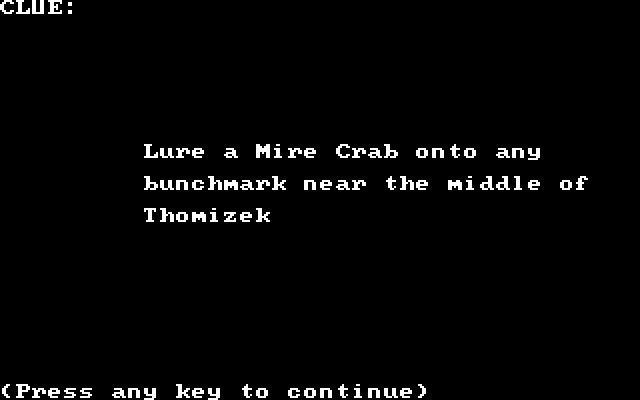  : Really? Any of them? : Really? Any of them? : Yep. : Yep. : How does that even remotely work? : How does that even remotely work? : That's a good question with a very interesting answer! : That's a good question with a very interesting answer! : Go on. : Go on. : The fee for this information is 7,000 green chips. : The fee for this information is 7,000 green chips. : Oh no you don't. : Oh no you don't. : What. : What. : You saw how long it took me to meet your last price. If you provoke me hard enough I will completely destroy the entire economy in this whole region and nobody in the Galaxy will extend it any credit for decades. : You saw how long it took me to meet your last price. If you provoke me hard enough I will completely destroy the entire economy in this whole region and nobody in the Galaxy will extend it any credit for decades. : You're bluffing. : You're bluffing. : Am I. I can turn 1,600% profits in hours without even having any products or services to trade. : Am I. I can turn 1,600% profits in hours without even having any products or services to trade.  : ... : ... : So spill it. Or don't. After all, one way or another I'll end up finding out anyway. : So spill it. Or don't. After all, one way or another I'll end up finding out anyway. : I suppose that's true. There isn't much to tell, anyway. Every Bunchmark is the site of an old access path to one of the Old Cities. The legends say that when the Cities lived, the Darksome Mire wasn't a Mire, and that all of them drowned in some calamity that also created the Mire itself. : I suppose that's true. There isn't much to tell, anyway. Every Bunchmark is the site of an old access path to one of the Old Cities. The legends say that when the Cities lived, the Darksome Mire wasn't a Mire, and that all of them drowned in some calamity that also created the Mire itself. : Metallica's access hatch. : Metallica's access hatch. : Hm? : Hm? : Metallica's access hatch is an excavated Bunchmark. : Metallica's access hatch is an excavated Bunchmark. : Got it in one. Metallica was a smaller city, mostly automated. It only had one access path, and that's probably what saved it when the Mire drowned the land. : Got it in one. Metallica was a smaller city, mostly automated. It only had one access path, and that's probably what saved it when the Mire drowned the land. : That's a kick in the teeth. How advanced were the cities? : That's a kick in the teeth. How advanced were the cities? : Not spectacular, by Galactic standards, but not terrible. There's still a trickle of trade through Metallica, but the Galactics mostly left us to our fate after the disaster. : Not spectacular, by Galactic standards, but not terrible. There's still a trickle of trade through Metallica, but the Galactics mostly left us to our fate after the disaster. : That's silly. Who'd ignore a massive crisis like that? : That's silly. Who'd ignore a massive crisis like that? : You aren't from the Mire. When was the last time your continent had an interstellar trading delegation? Or even a tourist? : You aren't from the Mire. When was the last time your continent had an interstellar trading delegation? Or even a tourist? : ... this is an excellent point. : ... this is an excellent point. : Metallica is the key. It will get us what we need to rebuild, and once we all have our act together again, Porquatz will actually matter on the interstellar stage again. : Metallica is the key. It will get us what we need to rebuild, and once we all have our act together again, Porquatz will actually matter on the interstellar stage again. : I'm on board. Do you think the Most Amazing Thing will help with the project? : I'm on board. Do you think the Most Amazing Thing will help with the project? : Depends on which of our old stories I decide to believe. Maybe it'll be necessary. Maybe it's a crutch we can't afford to rely on. Maybe it will doom the entire project. : Depends on which of our old stories I decide to believe. Maybe it'll be necessary. Maybe it's a crutch we can't afford to rely on. Maybe it will doom the entire project. : The more I learn about this, the less thrilled I am about the prospect of actually finding it. : The more I learn about this, the less thrilled I am about the prospect of actually finding it. : Hey, it's not my quest. Good flying, kiddo. : Hey, it's not my quest. Good flying, kiddo.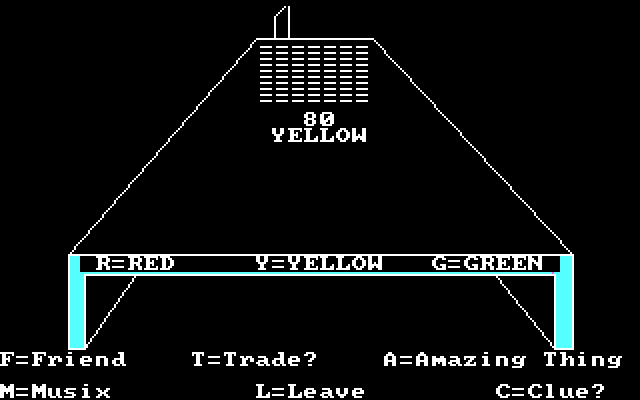  : You've been a great help. Here, I have too many green chips. Let's balance my portfolio out a bit. : You've been a great help. Here, I have too many green chips. Let's balance my portfolio out a bit. : Perfect! We'll never have to manually brush our own teeth again! : Perfect! We'll never have to manually brush our own teeth again!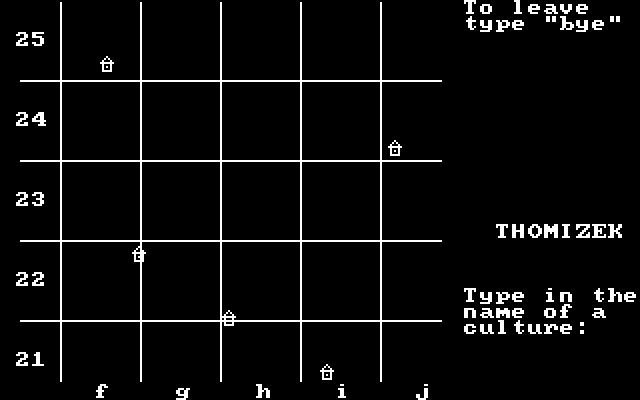 As the trader said, Thomizek lands are to the west. Any of these 25 sectors will work, but it's probably simplest to land in the I22 area or so and then search in a spiral pattern for Bunchmarks. 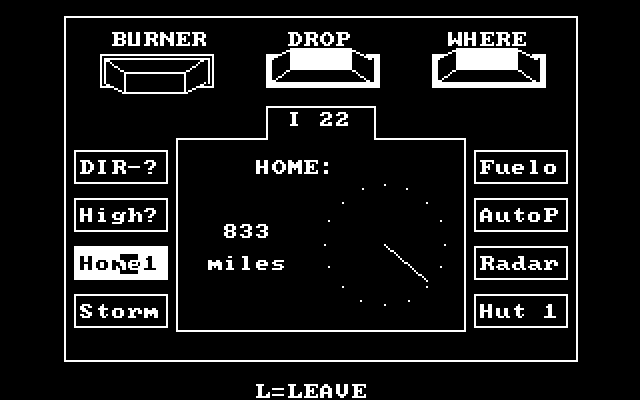 We are a long, long way from home. Still, when we're looking for generic features, any part of the Mire is much like any other. A bit more driving, and...  ... here we go. Now we just need to get a Mire crab to attack us on it. Mire crabs are summoned by driving fast, so I start doing donuts near a screen boundary to see if I can get a crab to show up. 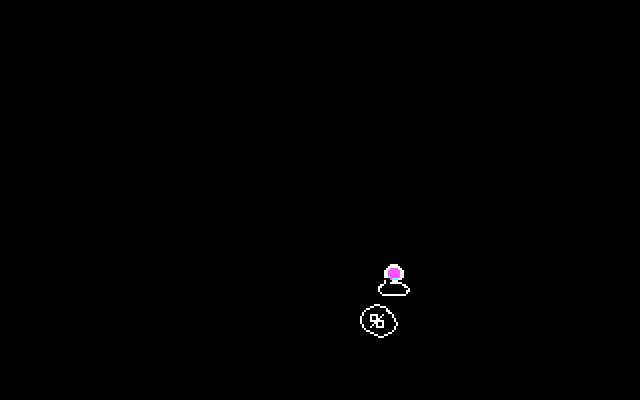 I do, but I'm not actually able to get to the Bunchmark before it disables the B-Liner.  This is a more promising setup. In this screen the crab is still asleep when I arrived, so I crept up near it and then revved my engine just enough to wake it up and then slammed the brakes on top of the bunchmark itself.  The crab, as is its wont, bashes itself repeatedly against the side of the B-Liner, but before it can knock us out, it sinks into the tar. 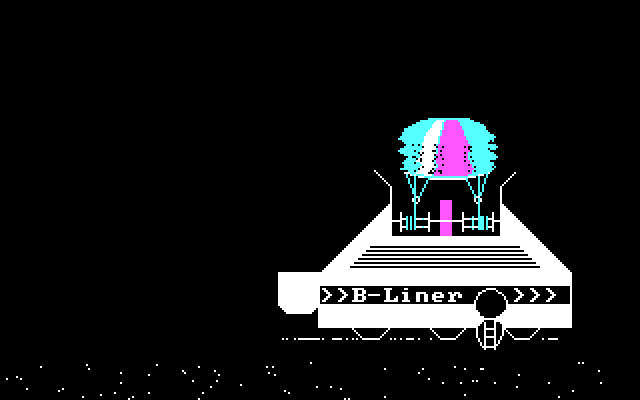 We follow.
|
|
|
|
So the actual clue is the one line shown as a screenshot, and the story around it is LP-only right?
|
|
|
|
The Lone Badger posted:So the actual clue is the one line shown as a screenshot, and the story around it is LP-only right? Details outside of screenshots are either things I made up or details I stole from the novella that came with the game, in about a 20:80 ratio. In particular, the Most Amazing Thing being a large, heavy golden sphere that grants wishes and which was dumped into the Mire is explicit in the novella, as is Merton, the Girfleez companion who helped Smoke find it. The Most Amazing Thing holding "the secret of the universe" as mentioned in the introductory demo text is specific to the game. As a rule, the game is pretty sparse about the details it gives, but it does often make pretty extensive references to the manual and to the novella directly at various points. The clues that lead you to the Most Amazing Thing... are not among those points. I get the distinct impression that these clues are what they are not for any story reasons but because they were actions where it was easy to implement detecting if the player did them. ManxomeBromide fucked around with this message at 09:14 on Dec 8, 2019 |
|
|
|
Part 7: A Connection to History In the aftermath of the Mire Crab attack, we exit the B-Liner and also sink into the Mire. 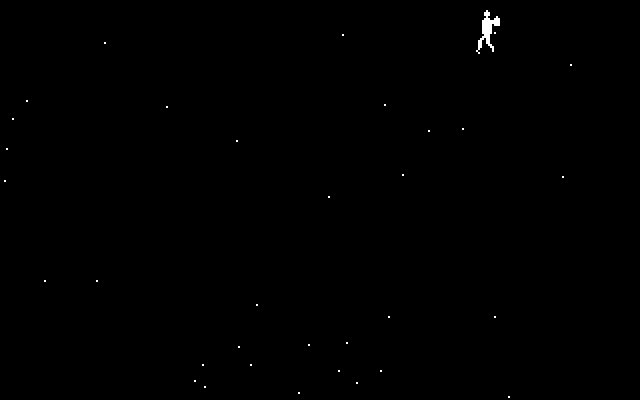 ... and keep sinking, and keep sinking. The tar is more like water here, and hints of sunlight still manage to penetrate the depths a bit. Fortunately for us, our environment suit is airtight. This seems like a good a time as any to note that I haven't been cutting anything from the material the game presents. Anything in a screenshot is something that the game tells you. Anything in the text that I'm attributing to either Smoke, Merton of the Girfleez, or someone who's heard about something they did is a detail I've lifted from the manual or from the novella. Pretty much everything else is my own invention: an attempt to impose a coherent narrative on the events of the game, or to reconcile the game's behavior with the stories in the manual and the novella. So I want to be particularly clear that in the novella, The Most Amazing Thing is a golden ball that grants wishes and was designed to be opened to bathe you in eldritch energies of unknown provenance and power. It also was defended by a fire-breathing dragon that wasn't wish-proof but thanks to the events of the novella we don't really have to worry about that here. Eventually we hit a hard surface, and with a ragged whine an automated airlock, closed for centuries, spills us and a cubic meter of watery tar into a vast plaza. This must have been one of the Old Cities. Nothing of note remains; the ravages of time have collapsed every building, and the encroaching Mire has drowned the rest in a grim slurry of rock and sludge. But our attention is drawn to a particular clearing, and as we approach, we detect a glint of gold. Could this be it? Any doubt is erased as we cut our jetpack's thrust and alight in the clearing. A ghostly form takes shape before us and a voice insinuates itself into our minds.  (... and as per protocol, you may claim two wishes from the Masters of Time and Space.) (... and as per protocol, you may claim two wishes from the Masters of Time and Space.)Ever since our conversation with the Muhill, we knew what our first wish would be: the reintegration of Porquatz into Galactic society. We begin to formulate the wish in our minds when we are interrupted.  (We were not talking to you.) (We were not talking to you.)A chunk of rubble about half the size of the B-Liner's cabin suddenly stirs and begins to move about on the plaza's ruined tiles. It's the Mire Crab we lured down here!  (For fifty years a horrible, immortal metal crab has traveled our lands, making terrible noises and awful smells and often flying away from our vengeance. My first wish is for it to lose its way. My second wish is to be granted the power to destroy it.) (For fifty years a horrible, immortal metal crab has traveled our lands, making terrible noises and awful smells and often flying away from our vengeance. My first wish is for it to lose its way. My second wish is to be granted the power to destroy it.) (Hey!) (Hey!) (Your wishes have been granted.) (Your wishes have been granted.) (I'm standing right here! What am I, chopped liver?) (I'm standing right here! What am I, chopped liver?) (Probably, soon enough.) (Probably, soon enough.)  The Mire Crab strides up to the golden sphere and crushes it in its claw. The sphere cuts neatly in half, but a smaller, black sphere, surrounded by a coruscating energy field, rolls out. The plaza fills with colored light and strange smells, and we are enveloped in a haze of light, sound, and smell that we cannot fully comprehend.   (Fools.) (Fools.) (How dare you resist my claws?) (How dare you resist my claws?) (Five hundred years after we drowned the continent, and your hearts' desires are still nothing but spite and avarice. We were too merciful. This time, we must scour all of Porquatz.) (Five hundred years after we drowned the continent, and your hearts' desires are still nothing but spite and avarice. We were too merciful. This time, we must scour all of Porquatz.)The Mire Crab snaps all its limbs back into its shell, looking once again like any other chunk of rubble. We feel a crushing despair, but a strange fire burns within us and we realize that the despair is not our own—that the Most Amazing Thing intends to cow us into submission. We stand taller and find our voice.  No. I won't let you. No. I won't let you.The force field around the Thing's core glows brighter. Blue bolts of energy arc from the Mire Crab's shell to the field, but they seem to do nothing to it.  (KNOW YOUR PLACE, cowpoke. You have no idea where you belong, or of your limits. Behave as you should.) (KNOW YOUR PLACE, cowpoke. You have no idea where you belong, or of your limits. Behave as you should.)Another wave of terror, despair, and humility washes over us, but this time, we let it settle upon us without letting it take hold.  You're right. I don't know my place. I don't know my limits. You're right. I don't know my place. I don't know my limits.The force field around the Thing begins to fade. Once we can no longer see it, we sweep aside the Thing's attempts to crush our will and lash out against it ourselves. Our vision fades to white. Are we being attacked? We feel no pain or disorientation, so we bring our full will to bear against the malevolent consciousnesses that assail us.  : I don't know my place because my journeys are not over. And I don't know my limits... : I don't know my place because my journeys are not over. And I don't know my limits...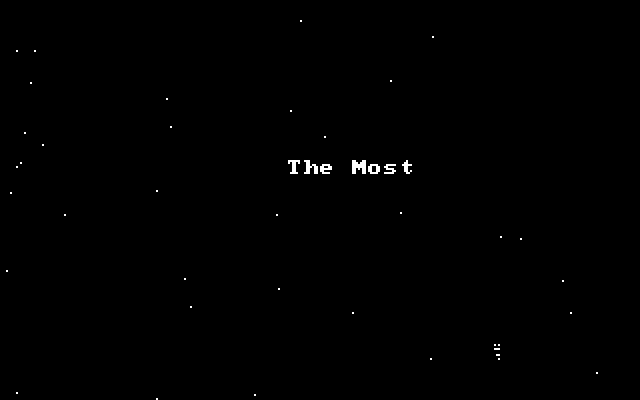  : Because I haven't found them yet. : Because I haven't found them yet.When our vision clears, the core of the Most Amazing Thing is a smoldering ruin, and the projected images are nowhere to be found. Did we do this? Did the Mire Crab get a stun bolt through when it dropped its shields? We still feel the presence of another conciousness, though. Spiteful, resentful, hostile, but not immediately murderous.  : (Amazing work. I don't know where you found the strength to defy that thing, but it would have wrecked our home. You lent me the strength to fight back too.) : (Amazing work. I don't know where you found the strength to defy that thing, but it would have wrecked our home. You lent me the strength to fight back too.) : (This is my home too. Thank you for your help.) : (This is my home too. Thank you for your help.) : (I will give you the greatest boon my people can offer...) : (I will give you the greatest boon my people can offer...)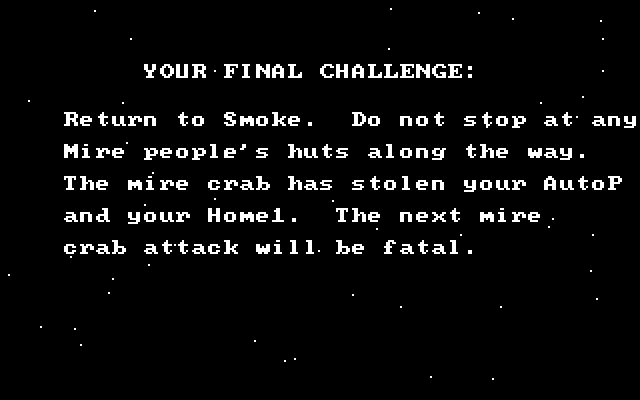  : (A five minute head start.) : (A five minute head start.) : (Understood. We will not meet again.) : (Understood. We will not meet again.)Surprise! It's time for the endgame, where we now need to find our way back to Metallica by dead reckoning, and also, suddenly, permadeath exists. It's not kidding about "the next attack will be fatal". If you get hit by a Mire Crab from here on out, you'll get this message... 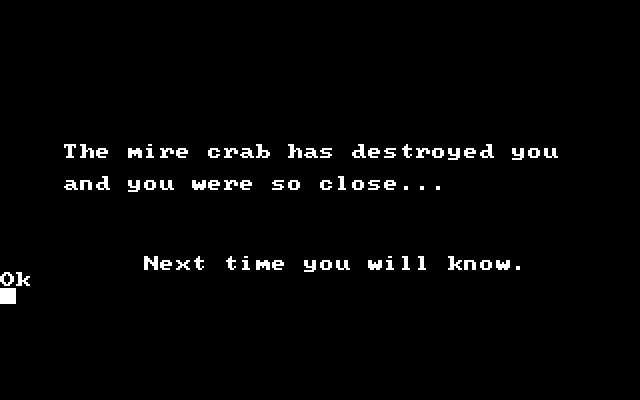 ... and it will delete your savegame. If we talked to Smoke a great deal, or slept a lot during the game, we'd get a bit of warning about this: I'm not sure why we're forbidden from visiting any Mire Huts; there isn't anything we can trade for that would help or hinder us in any way. I think the game might be trashing and reusing event flags to save on space, but I must admit I'm a bit Anyway. A crisis has landed in our lap. Let's deal with it. Step 1 is to not panic. Mire Crabs cannot attack us if we are in the air, so let's launch the B-Liner. 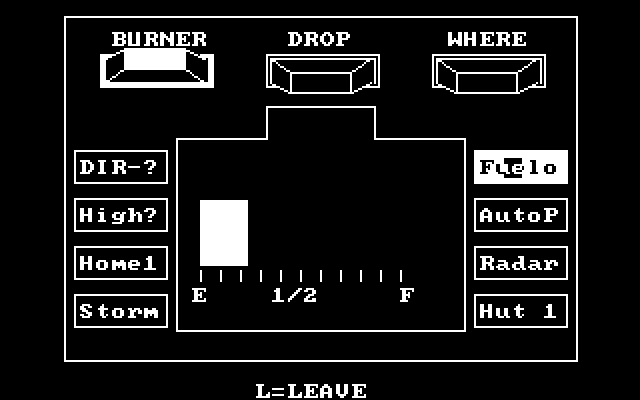 Unfortunately, the Mire Crab attacks we took to open the endgame have done a number on our fuel reserves. We're over 800 miles from home and we aren't getting any 800 miles on this tank of gas. We'll need to mine a Night Rock to have a decent shot at making it home, but if we carelessly approach one, it might be a Mire Crab, and there's no escaping a Mire Crab we slam into face first. But we know how to defend against Mire Crabs, don't we?  We drive, very slowly, to a zone boundary, and then cruise east along it (hey, it gets us marginally closer to home as we search) until we can find a rock that's close to the boundary. Then, on the other side of the boundary, we drive really fast and see if it gets mad and then suicides against the boundary. This one doesn't! It must be a rock. 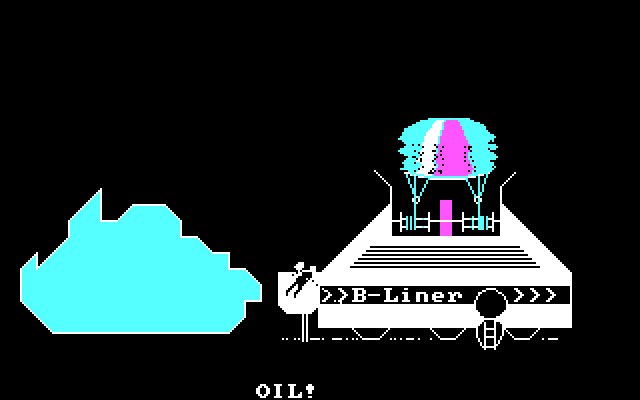 Excellent. 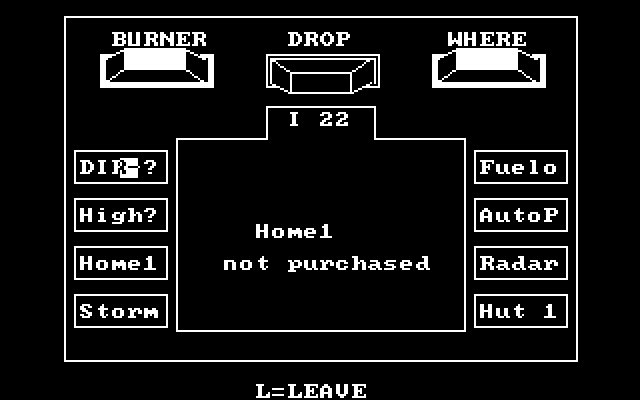 Oh, it was purchased all right, we just had it stolen from us by a giant enemy crab  Metallica is, generally speaking, to the Southeast. We don't have incredibly precise control over our direction, so Vaguely Southeast And Fast is how we roll. 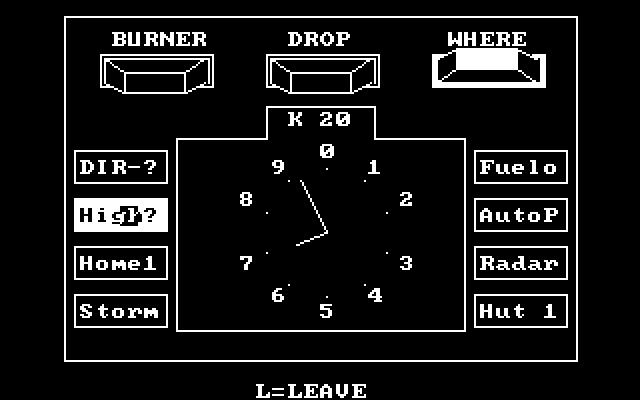 It's a good way up our operating altitude. 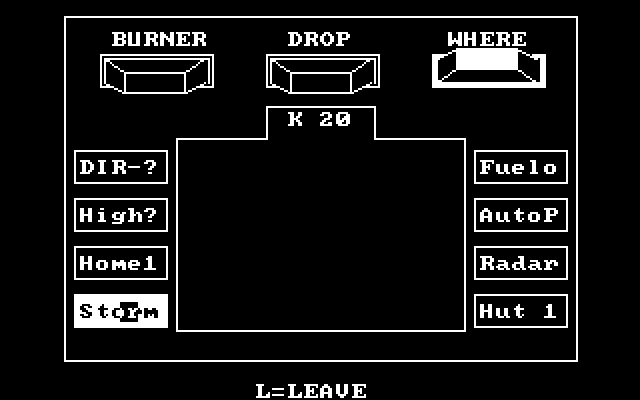 Even in the endgame, no storms. Not that I am complaining. 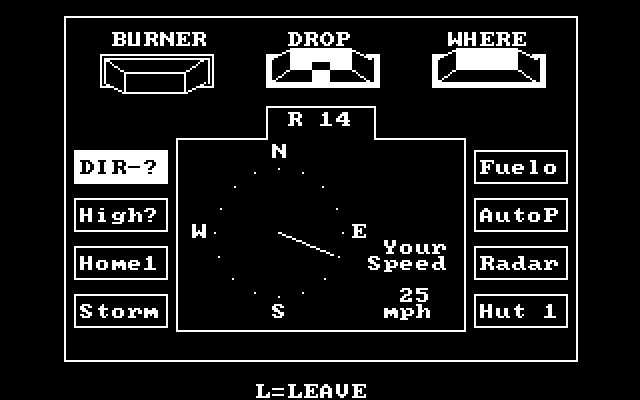 Metallica is in sector R15. We've overshot to the south. But it's not time to turn around. I vent some hot air and continue flying east for a bit, drifting a touch north as I go. 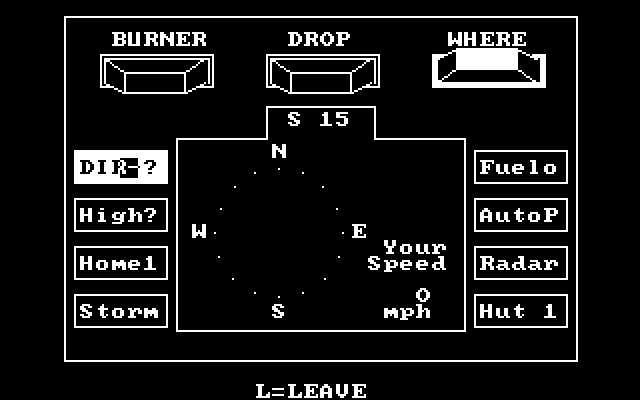 Now I've overshot a bit to the east as well, so now it's time to land. It's an odd choice, perhaps; what's my play here?  My landing is implausibly precise. I've landed on the dividing line between row 15 and row 14, and three screens west...  ...I'm also at the division between the R and S files. Remember back in Update 3 when we drove out to this meridian? That's our ticket home. Metallica is 15 miles west of this meridian, and (though we didn't show it in the screenshots) somewhere between 10 and 20 screens north of this parallel. 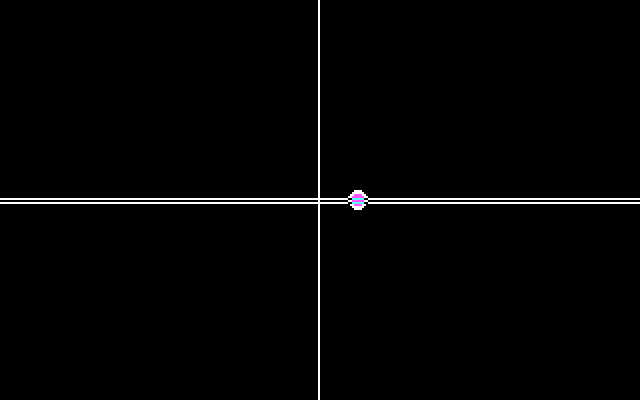 10 screens west, and I turn north; this way I'll spend as much time as possible on the lines and have the best chance of avoiding or cancelling Mire Crab attacks. I could still be hosed if a Mire Crab spawns right on my face after a screen transition, but hey, that keeps things exciting. One of the things this game teaches us, perhaps, is that sometimes the world will just do you irreversible damage for no reason and with no recourse available. Speaking of Mire Crabs being a danger while driving the line...  NOT TODAY, SATAN. I throttle down to the slowest speed that isn't completely stopped and describe a very wide semicircle around that jerk. Soon enough I'm at the magic fifteen screens west mark, and soon enough after that...  ... Metallica itself comes into view. 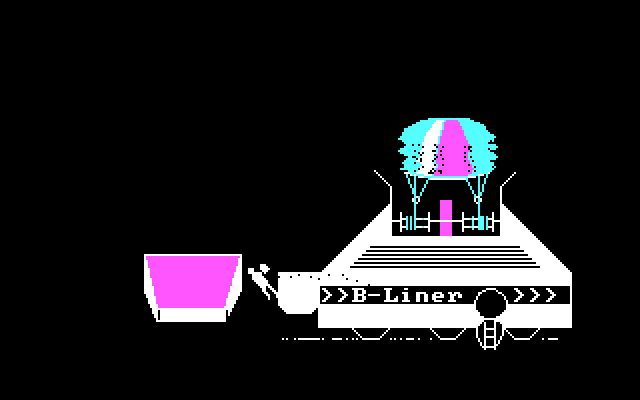 We fly up to the port and open the access hatch one last time. 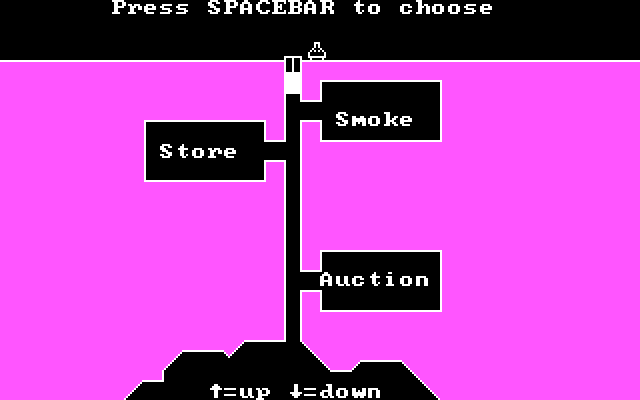 Now all that's left is to go back to Uncle Smoke and tell him everything that's happened. 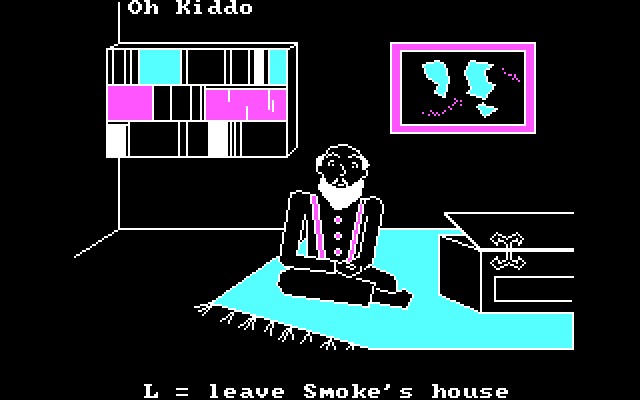 And after being congratulated in-fiction by Uncle Smoke, we are congratulated out-of-fiction by the narrator in a wall of text: 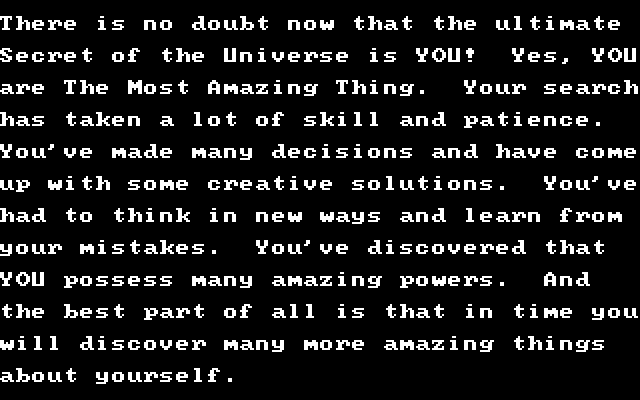 I... yeah. I don't know about this. It's intended to be a rewarding pep talk for a player who's managed to finish the game, but if the target age range is 10-12, the tone is pitched just a little too young. Remember, this is the target age range for Ender's Game and the early Harry Potter books. Every 12-year-old I've met would be rolling their eyes clear out of their skulls at a speech like this, but I can think of some 7-year-olds who'd have been thrilled by it. The gameplay, though, is definitely out of reach of most 7-year-olds, at least without help. It's an odd clash of tone, gameplay, and marketing, and in a very real sense I suspect it is the inexperience of the industry at the time.  After a few seconds to read the message, we are then dumped back to BASIC. The Game Structure For a game with such a mind-boggling huge map and so many only-loosely-connected gameplay systems, finding The Most Amazing Thing is a pretty linear process:
Along the way you'll eat and sleep and mine for fuel but none of those things can actually stop you. The hunger and sleep warnings just get really obnoxious, and while flying is infinitely better than driving it's not actually mandatory the way playing Musix for traders to get clues is. What, Exactly, Did We Learn Here? And so ends our quest for the Most Amazing Thing, in simultaneous white-knuckled terror and crashing anticlimax. Looking back on our journey, it's worth remembering: this was supposed to be an educational game. What, exactly, were we supposed to be learning here? 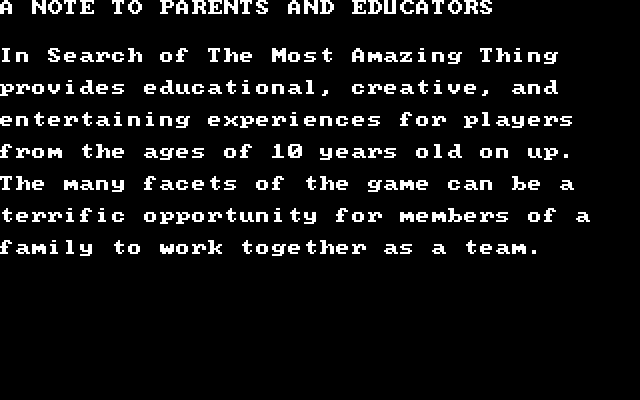 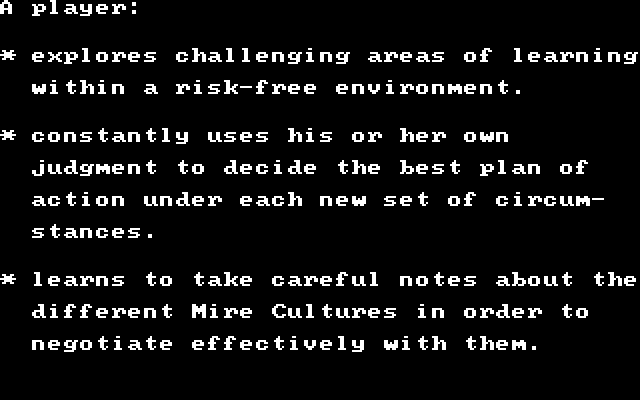 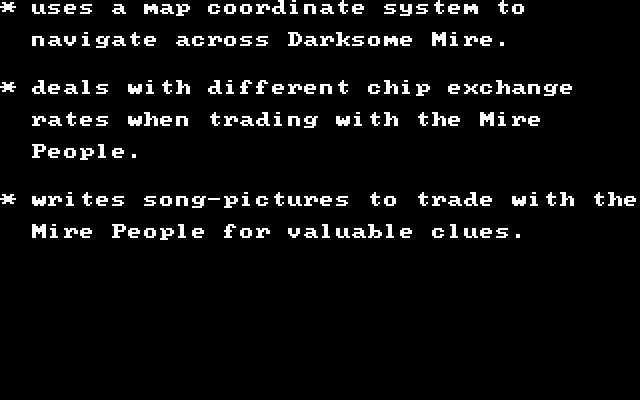 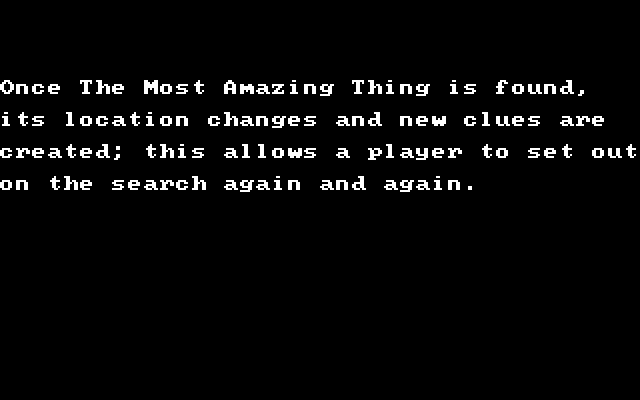 The manual's section on this is similar. quote:Anyone from the age of 10 years old on up will enjoy this game. Some of the phrasing here is weirdly awkward as well, but the core claim is quite audacious to modern eyes. The basic premise here is that this was a complicated action-adventure game, and complicated action-adventure games are inherently educational. And honestly, it's a pretty solid claim, and one that gets stronger when you remember that the Carmen Sandiego games were not really about teaching kids about geography. They were about teaching kids how to look stuff up in reference books. I don't think, even at the time, that a child who cleared the game would find a lot of replay value in it. The Darksome Mire is too samey, and the quest ultimately too linear and unchanging, for the wires to not be immediately visible to the player on the second playthrough, let alone the third. But in the end, it's the fifth paragraph that really gives us, here in 2019, the lesson we would not have gotten as children back in 1983: We would do well to play Zelda games together with our children.
|
|
|
|
this was a fascinating game about which I knew nothing until this Let’s Play. Thank you!
|
|
|
|
Even as a six-year-old, I found this line slightly cheesy. I mean, I went to all the trouble to track down this shapeshifting mystery object, and it turns out that it was me all along? At the same time, it was kind of an uplifting concept at that age. It did become a family joke for a little while, though.
|
|
|
|
Thanks for a wonderful LP! I'm not entirely clear on what actually happens onscreen when you descend into the mire.
|
|
|
|
Basically, it's the screenshots in order. You get the normal animation for the mire crab attack, then it cuts to you descending into the mire for two and a half screens, then you get the "The Most Amazing Thing now is you, kiddo" message with a bunch of animated box-drawing making it occasionally hard to read, then you get the "FINAL CHALLENGE" text, then you are dropped back into the B-Liner cockpit. The narrative I imposed on this was to lean hard on how the Most Amazing Thing is now us and to combine it with the details from the Novella that the Thing could be opened, which would destroy it but unleash some kind of vast force, and so I had that happen in the narrative, and for it to empower us somehow. The gimmick that it destroys civilizations that are too violent about opening it up was stolen from the excuse plot from the old shmup Zanac, which I also played a lot of back then, and whose name I anagrammized to get the Most Amazing Thing's code in the Galactic Store. 
|
|
|
|
Yeah, the implication I got from the game itself is that you, the player, have always been the Most Amazing Thing.
|
|
|
|
And hey, at the point this is revealed, you are in fact an object buried deep somewhere in the Darksome Mire!
|
|
|
|
It turns out that Uncle Smokes "quest" for us was actually a clever ruse, as his brother, your father, was actually a vastly wealthy widower before he passed away and left everything to you. Uncle Smoke, having squandered his share of the family fortune on a frivolous quest that ended in abject failure, came up with a plan to send you out to find the thing he has "found" years ago. He knew it didn't exist, and that you were going to die at the hands of the mire crabs, was prepared to wait in Metallica long enough to declare you legally dead and seize your father's estate for himself. Unfortunately for him, you survived and returned to expose his crimes.
|
|
|
|
ManxomeBromide posted:And hey, at the point this is revealed, you are in fact an object buried deep somewhere in the Darksome Mire!
|
|
|
|
Becoming a Djinn isn't exactly the worst reward, presuming the wish-granting wasn't a lie.
|
|
|
|
I think I would have had a very "be sure to drink your Ovaltine" feeling from that climax if I had actually gotten that far as a child. But wow, am I glad to actually know what I was missing!
|
|
|
|
Thank you for doing this! This was a charming read.
|
|
|
|
What if... It wasn't a metaphor in any way? Do we actually have parents? Why did Smoke send us in that quest? What if not all the Thing was sunk, and we became one with ourselves once more...
|
|
|
|
Our parents appear in the novella, which I'm treating as canon, so we definitely have parents.
|
|
|
|
But are they alive at the time the game starts?
|
|
|
|

|
| # ? May 7, 2024 10:44 |
|
The thread is up on the archive. Also, while spelunking in some of the dustier corners of my childhood home over the holidays, this turned up. 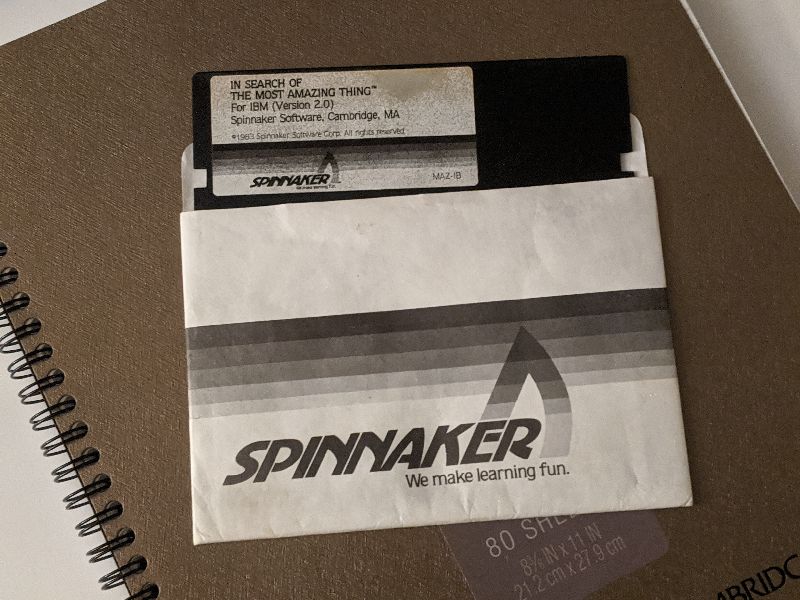 Thanks for coming along with me on this ride, everyone. See you next time, whenever that might be.
|
|
|











